Computerized Accounting in an ERP System with SAP S/4HANA Finance
VerifiedAdded on 2023/06/07
|20
|4732
|83
AI Summary
This report explains the use of computerized accounting in an ERP system with SAP S/4HANA Finance. It discusses the benefits of SAP S/4HANA Finance for businesses and the challenges faced while migrating to it. The report includes a historical overview of SAP S/4HANA Finance, differences between SAP ERP FICO and SAP S/4HANA Finance, and two case studies to illustrate the issues faced during migration.
Contribute Materials
Your contribution can guide someone’s learning journey. Share your
documents today.
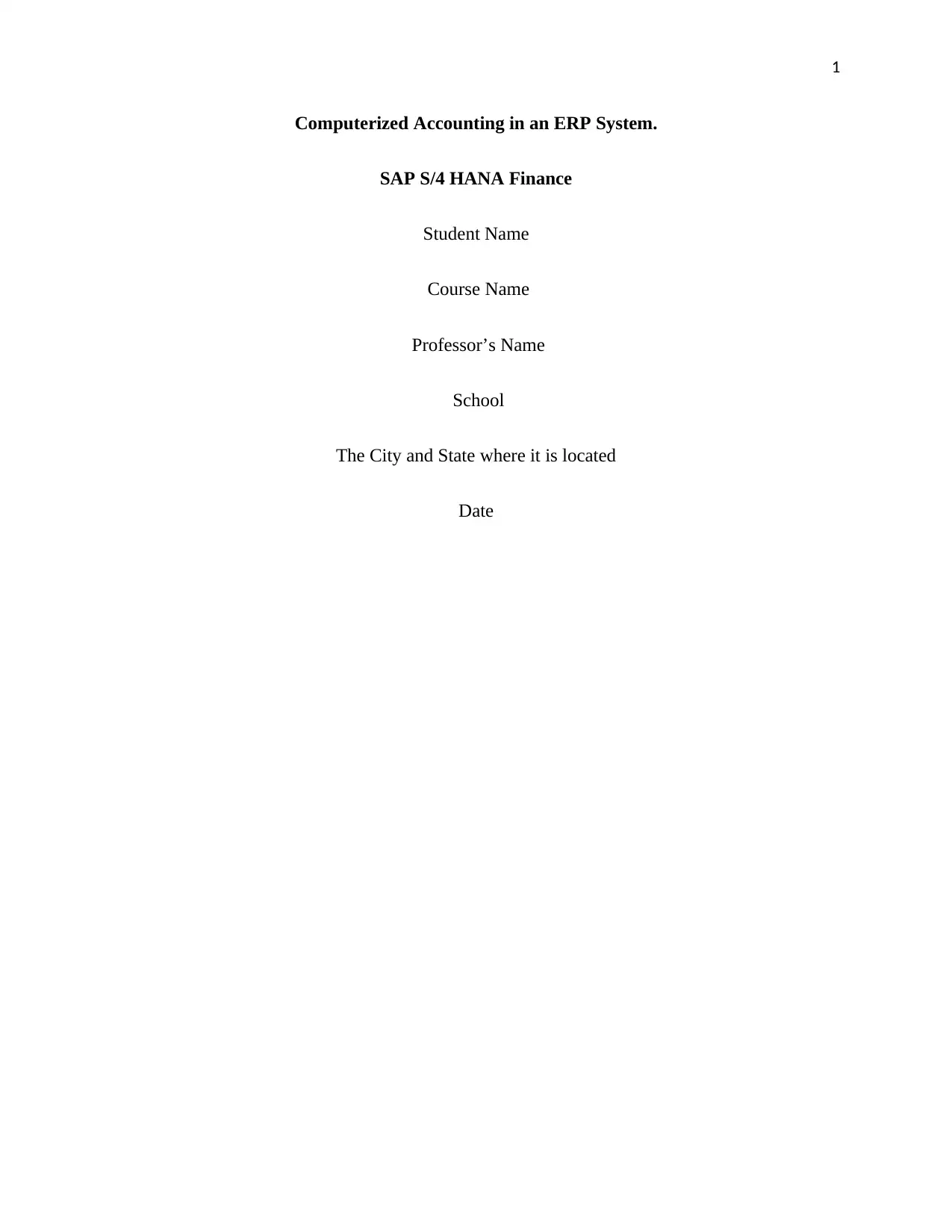
1
Computerized Accounting in an ERP System.
SAP S/4 HANA Finance
Student Name
Course Name
Professor’s Name
School
The City and State where it is located
Date
Computerized Accounting in an ERP System.
SAP S/4 HANA Finance
Student Name
Course Name
Professor’s Name
School
The City and State where it is located
Date
Secure Best Marks with AI Grader
Need help grading? Try our AI Grader for instant feedback on your assignments.
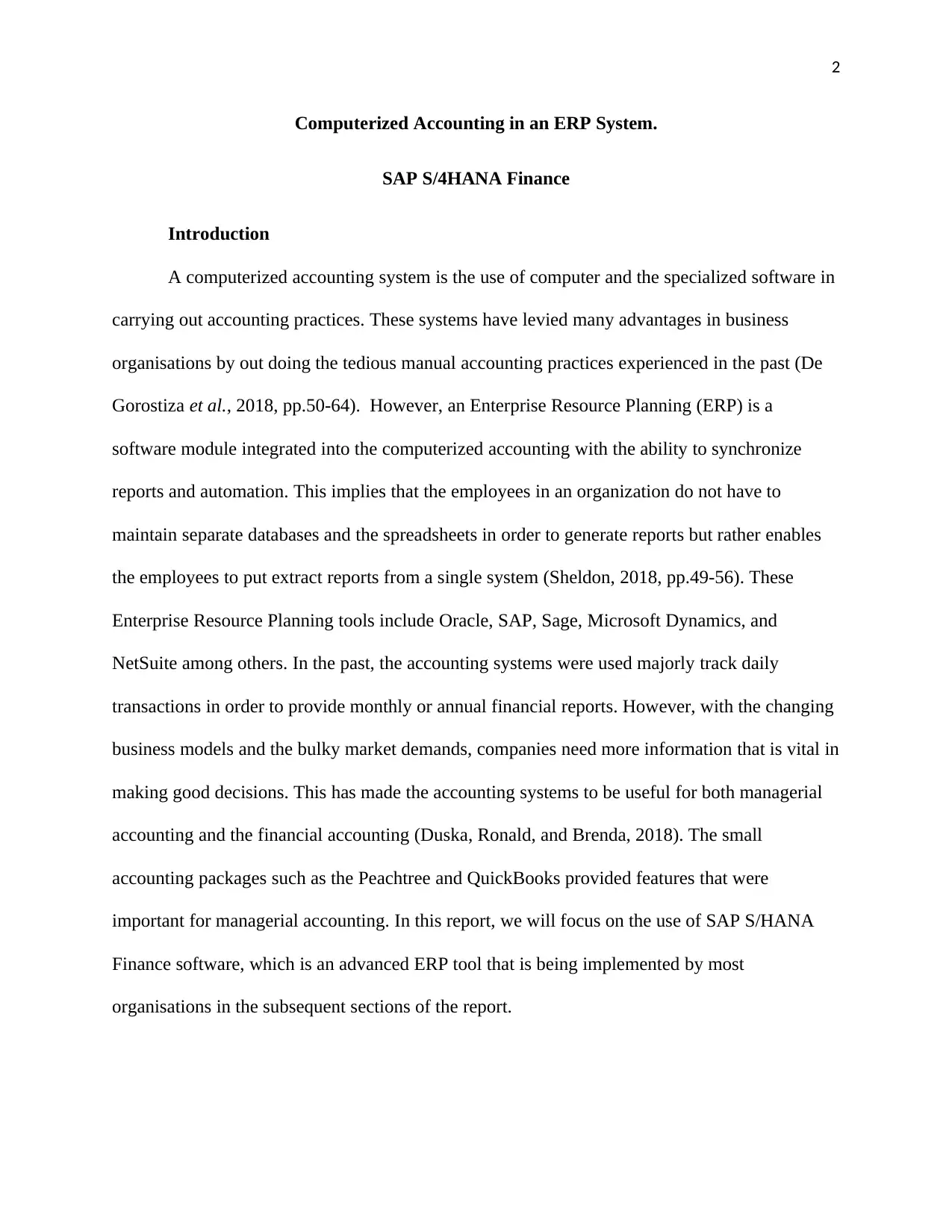
2
Computerized Accounting in an ERP System.
SAP S/4HANA Finance
Introduction
A computerized accounting system is the use of computer and the specialized software in
carrying out accounting practices. These systems have levied many advantages in business
organisations by out doing the tedious manual accounting practices experienced in the past (De
Gorostiza et al., 2018, pp.50-64). However, an Enterprise Resource Planning (ERP) is a
software module integrated into the computerized accounting with the ability to synchronize
reports and automation. This implies that the employees in an organization do not have to
maintain separate databases and the spreadsheets in order to generate reports but rather enables
the employees to put extract reports from a single system (Sheldon, 2018, pp.49-56). These
Enterprise Resource Planning tools include Oracle, SAP, Sage, Microsoft Dynamics, and
NetSuite among others. In the past, the accounting systems were used majorly track daily
transactions in order to provide monthly or annual financial reports. However, with the changing
business models and the bulky market demands, companies need more information that is vital in
making good decisions. This has made the accounting systems to be useful for both managerial
accounting and the financial accounting (Duska, Ronald, and Brenda, 2018). The small
accounting packages such as the Peachtree and QuickBooks provided features that were
important for managerial accounting. In this report, we will focus on the use of SAP S/HANA
Finance software, which is an advanced ERP tool that is being implemented by most
organisations in the subsequent sections of the report.
Computerized Accounting in an ERP System.
SAP S/4HANA Finance
Introduction
A computerized accounting system is the use of computer and the specialized software in
carrying out accounting practices. These systems have levied many advantages in business
organisations by out doing the tedious manual accounting practices experienced in the past (De
Gorostiza et al., 2018, pp.50-64). However, an Enterprise Resource Planning (ERP) is a
software module integrated into the computerized accounting with the ability to synchronize
reports and automation. This implies that the employees in an organization do not have to
maintain separate databases and the spreadsheets in order to generate reports but rather enables
the employees to put extract reports from a single system (Sheldon, 2018, pp.49-56). These
Enterprise Resource Planning tools include Oracle, SAP, Sage, Microsoft Dynamics, and
NetSuite among others. In the past, the accounting systems were used majorly track daily
transactions in order to provide monthly or annual financial reports. However, with the changing
business models and the bulky market demands, companies need more information that is vital in
making good decisions. This has made the accounting systems to be useful for both managerial
accounting and the financial accounting (Duska, Ronald, and Brenda, 2018). The small
accounting packages such as the Peachtree and QuickBooks provided features that were
important for managerial accounting. In this report, we will focus on the use of SAP S/HANA
Finance software, which is an advanced ERP tool that is being implemented by most
organisations in the subsequent sections of the report.
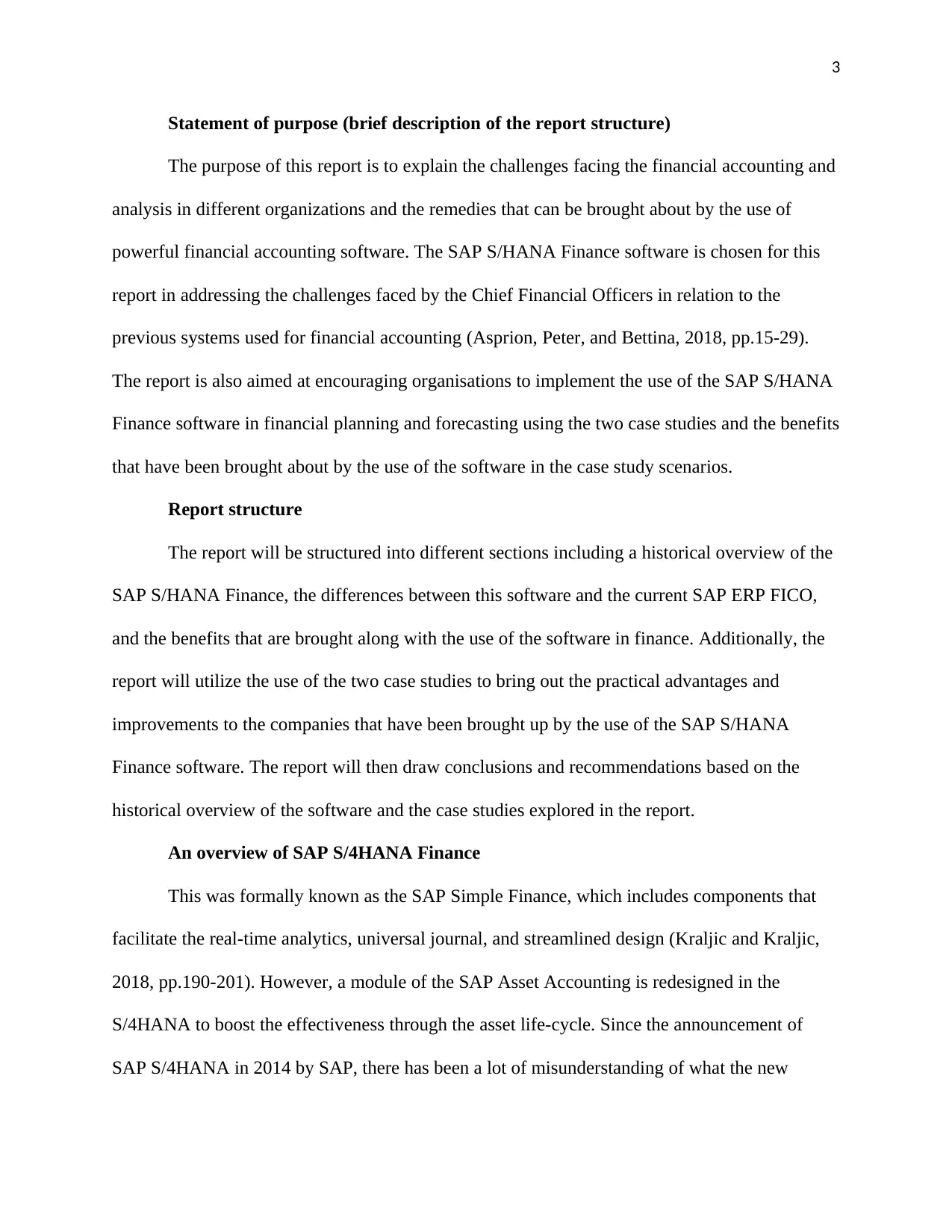
3
Statement of purpose (brief description of the report structure)
The purpose of this report is to explain the challenges facing the financial accounting and
analysis in different organizations and the remedies that can be brought about by the use of
powerful financial accounting software. The SAP S/HANA Finance software is chosen for this
report in addressing the challenges faced by the Chief Financial Officers in relation to the
previous systems used for financial accounting (Asprion, Peter, and Bettina, 2018, pp.15-29).
The report is also aimed at encouraging organisations to implement the use of the SAP S/HANA
Finance software in financial planning and forecasting using the two case studies and the benefits
that have been brought about by the use of the software in the case study scenarios.
Report structure
The report will be structured into different sections including a historical overview of the
SAP S/HANA Finance, the differences between this software and the current SAP ERP FICO,
and the benefits that are brought along with the use of the software in finance. Additionally, the
report will utilize the use of the two case studies to bring out the practical advantages and
improvements to the companies that have been brought up by the use of the SAP S/HANA
Finance software. The report will then draw conclusions and recommendations based on the
historical overview of the software and the case studies explored in the report.
An overview of SAP S/4HANA Finance
This was formally known as the SAP Simple Finance, which includes components that
facilitate the real-time analytics, universal journal, and streamlined design (Kraljic and Kraljic,
2018, pp.190-201). However, a module of the SAP Asset Accounting is redesigned in the
S/4HANA to boost the effectiveness through the asset life-cycle. Since the announcement of
SAP S/4HANA in 2014 by SAP, there has been a lot of misunderstanding of what the new
Statement of purpose (brief description of the report structure)
The purpose of this report is to explain the challenges facing the financial accounting and
analysis in different organizations and the remedies that can be brought about by the use of
powerful financial accounting software. The SAP S/HANA Finance software is chosen for this
report in addressing the challenges faced by the Chief Financial Officers in relation to the
previous systems used for financial accounting (Asprion, Peter, and Bettina, 2018, pp.15-29).
The report is also aimed at encouraging organisations to implement the use of the SAP S/HANA
Finance software in financial planning and forecasting using the two case studies and the benefits
that have been brought about by the use of the software in the case study scenarios.
Report structure
The report will be structured into different sections including a historical overview of the
SAP S/HANA Finance, the differences between this software and the current SAP ERP FICO,
and the benefits that are brought along with the use of the software in finance. Additionally, the
report will utilize the use of the two case studies to bring out the practical advantages and
improvements to the companies that have been brought up by the use of the SAP S/HANA
Finance software. The report will then draw conclusions and recommendations based on the
historical overview of the software and the case studies explored in the report.
An overview of SAP S/4HANA Finance
This was formally known as the SAP Simple Finance, which includes components that
facilitate the real-time analytics, universal journal, and streamlined design (Kraljic and Kraljic,
2018, pp.190-201). However, a module of the SAP Asset Accounting is redesigned in the
S/4HANA to boost the effectiveness through the asset life-cycle. Since the announcement of
SAP S/4HANA in 2014 by SAP, there has been a lot of misunderstanding of what the new
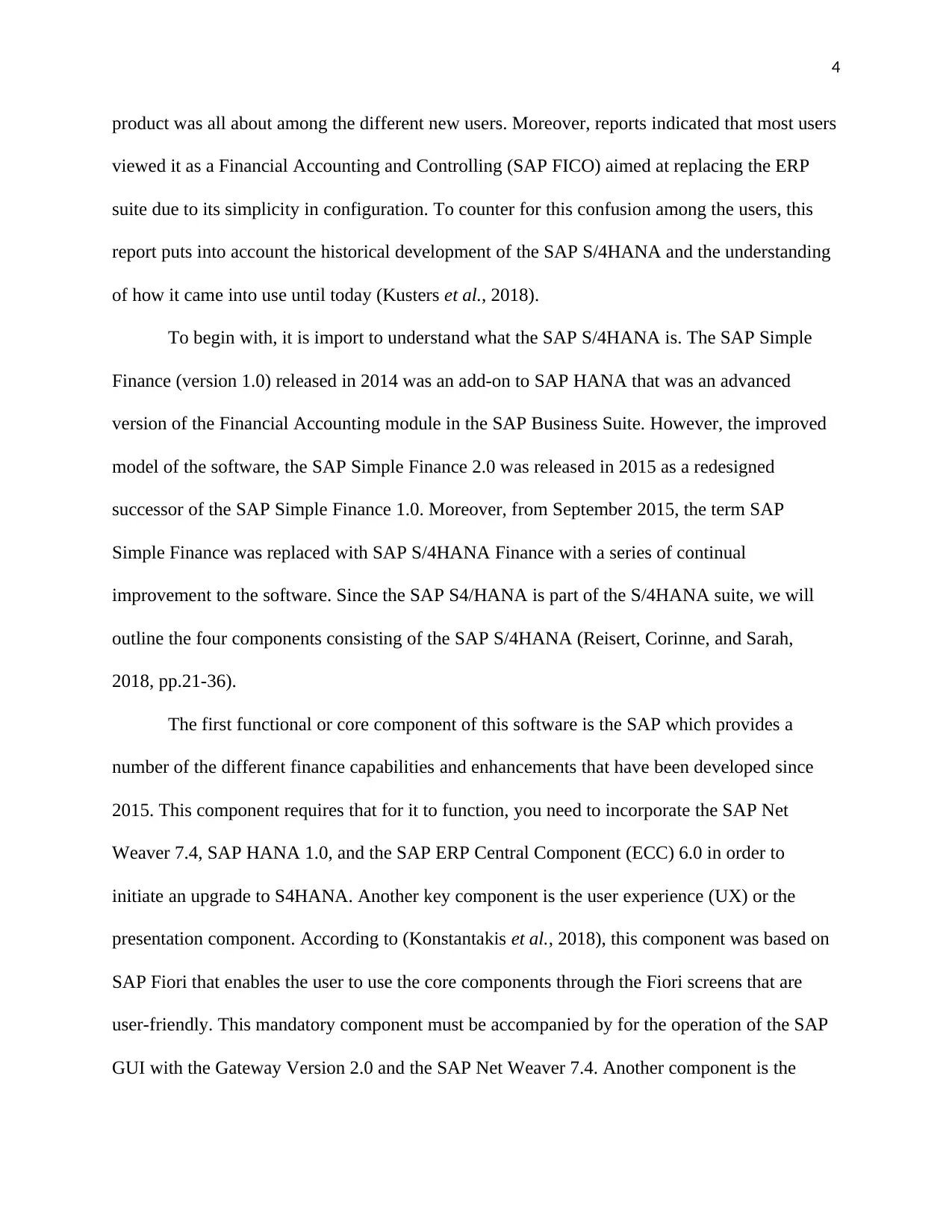
4
product was all about among the different new users. Moreover, reports indicated that most users
viewed it as a Financial Accounting and Controlling (SAP FICO) aimed at replacing the ERP
suite due to its simplicity in configuration. To counter for this confusion among the users, this
report puts into account the historical development of the SAP S/4HANA and the understanding
of how it came into use until today (Kusters et al., 2018).
To begin with, it is import to understand what the SAP S/4HANA is. The SAP Simple
Finance (version 1.0) released in 2014 was an add-on to SAP HANA that was an advanced
version of the Financial Accounting module in the SAP Business Suite. However, the improved
model of the software, the SAP Simple Finance 2.0 was released in 2015 as a redesigned
successor of the SAP Simple Finance 1.0. Moreover, from September 2015, the term SAP
Simple Finance was replaced with SAP S/4HANA Finance with a series of continual
improvement to the software. Since the SAP S4/HANA is part of the S/4HANA suite, we will
outline the four components consisting of the SAP S/4HANA (Reisert, Corinne, and Sarah,
2018, pp.21-36).
The first functional or core component of this software is the SAP which provides a
number of the different finance capabilities and enhancements that have been developed since
2015. This component requires that for it to function, you need to incorporate the SAP Net
Weaver 7.4, SAP HANA 1.0, and the SAP ERP Central Component (ECC) 6.0 in order to
initiate an upgrade to S4HANA. Another key component is the user experience (UX) or the
presentation component. According to (Konstantakis et al., 2018), this component was based on
SAP Fiori that enables the user to use the core components through the Fiori screens that are
user-friendly. This mandatory component must be accompanied by for the operation of the SAP
GUI with the Gateway Version 2.0 and the SAP Net Weaver 7.4. Another component is the
product was all about among the different new users. Moreover, reports indicated that most users
viewed it as a Financial Accounting and Controlling (SAP FICO) aimed at replacing the ERP
suite due to its simplicity in configuration. To counter for this confusion among the users, this
report puts into account the historical development of the SAP S/4HANA and the understanding
of how it came into use until today (Kusters et al., 2018).
To begin with, it is import to understand what the SAP S/4HANA is. The SAP Simple
Finance (version 1.0) released in 2014 was an add-on to SAP HANA that was an advanced
version of the Financial Accounting module in the SAP Business Suite. However, the improved
model of the software, the SAP Simple Finance 2.0 was released in 2015 as a redesigned
successor of the SAP Simple Finance 1.0. Moreover, from September 2015, the term SAP
Simple Finance was replaced with SAP S/4HANA Finance with a series of continual
improvement to the software. Since the SAP S4/HANA is part of the S/4HANA suite, we will
outline the four components consisting of the SAP S/4HANA (Reisert, Corinne, and Sarah,
2018, pp.21-36).
The first functional or core component of this software is the SAP which provides a
number of the different finance capabilities and enhancements that have been developed since
2015. This component requires that for it to function, you need to incorporate the SAP Net
Weaver 7.4, SAP HANA 1.0, and the SAP ERP Central Component (ECC) 6.0 in order to
initiate an upgrade to S4HANA. Another key component is the user experience (UX) or the
presentation component. According to (Konstantakis et al., 2018), this component was based on
SAP Fiori that enables the user to use the core components through the Fiori screens that are
user-friendly. This mandatory component must be accompanied by for the operation of the SAP
GUI with the Gateway Version 2.0 and the SAP Net Weaver 7.4. Another component is the
Secure Best Marks with AI Grader
Need help grading? Try our AI Grader for instant feedback on your assignments.
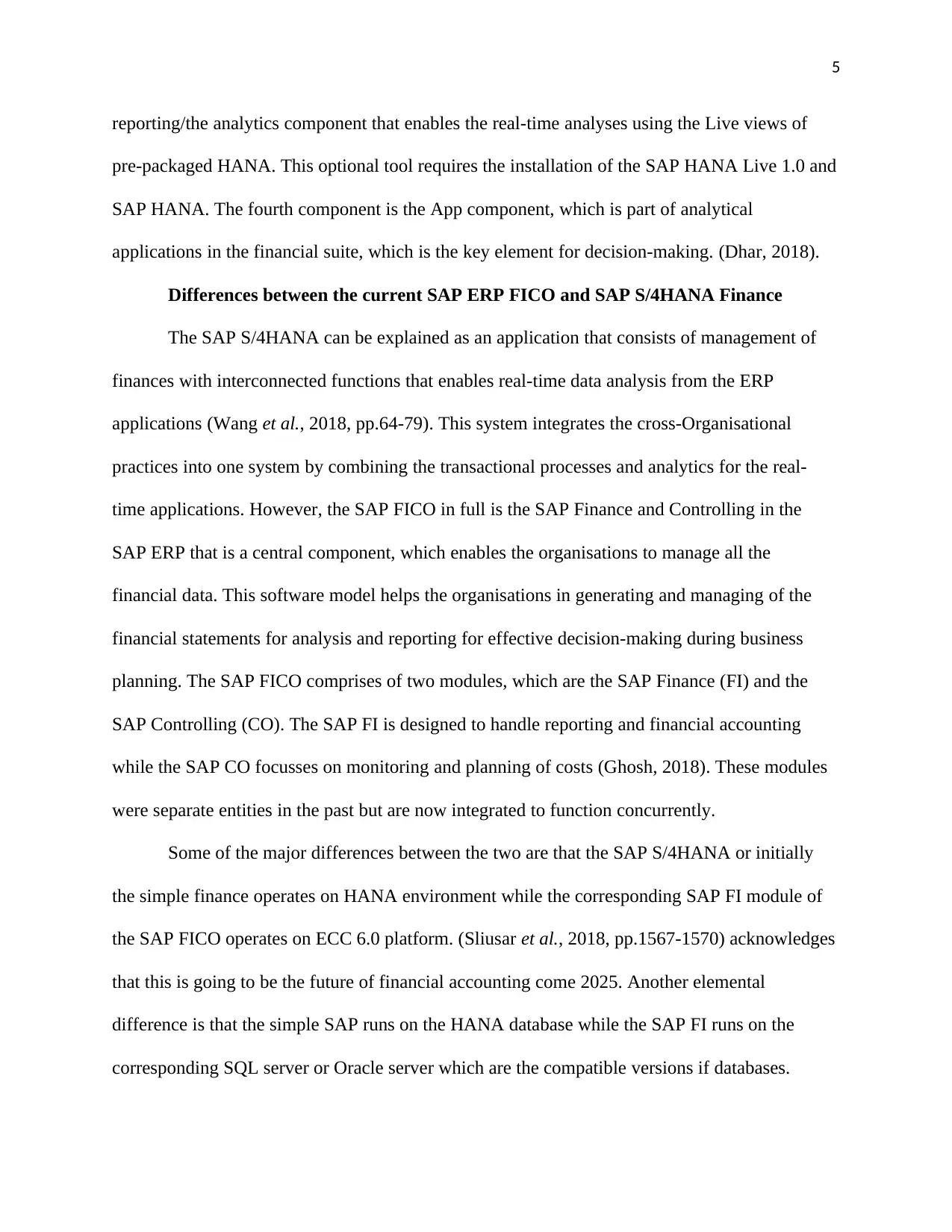
5
reporting/the analytics component that enables the real-time analyses using the Live views of
pre-packaged HANA. This optional tool requires the installation of the SAP HANA Live 1.0 and
SAP HANA. The fourth component is the App component, which is part of analytical
applications in the financial suite, which is the key element for decision-making. (Dhar, 2018).
Differences between the current SAP ERP FICO and SAP S/4HANA Finance
The SAP S/4HANA can be explained as an application that consists of management of
finances with interconnected functions that enables real-time data analysis from the ERP
applications (Wang et al., 2018, pp.64-79). This system integrates the cross-Organisational
practices into one system by combining the transactional processes and analytics for the real-
time applications. However, the SAP FICO in full is the SAP Finance and Controlling in the
SAP ERP that is a central component, which enables the organisations to manage all the
financial data. This software model helps the organisations in generating and managing of the
financial statements for analysis and reporting for effective decision-making during business
planning. The SAP FICO comprises of two modules, which are the SAP Finance (FI) and the
SAP Controlling (CO). The SAP FI is designed to handle reporting and financial accounting
while the SAP CO focusses on monitoring and planning of costs (Ghosh, 2018). These modules
were separate entities in the past but are now integrated to function concurrently.
Some of the major differences between the two are that the SAP S/4HANA or initially
the simple finance operates on HANA environment while the corresponding SAP FI module of
the SAP FICO operates on ECC 6.0 platform. (Sliusar et al., 2018, pp.1567-1570) acknowledges
that this is going to be the future of financial accounting come 2025. Another elemental
difference is that the simple SAP runs on the HANA database while the SAP FI runs on the
corresponding SQL server or Oracle server which are the compatible versions if databases.
reporting/the analytics component that enables the real-time analyses using the Live views of
pre-packaged HANA. This optional tool requires the installation of the SAP HANA Live 1.0 and
SAP HANA. The fourth component is the App component, which is part of analytical
applications in the financial suite, which is the key element for decision-making. (Dhar, 2018).
Differences between the current SAP ERP FICO and SAP S/4HANA Finance
The SAP S/4HANA can be explained as an application that consists of management of
finances with interconnected functions that enables real-time data analysis from the ERP
applications (Wang et al., 2018, pp.64-79). This system integrates the cross-Organisational
practices into one system by combining the transactional processes and analytics for the real-
time applications. However, the SAP FICO in full is the SAP Finance and Controlling in the
SAP ERP that is a central component, which enables the organisations to manage all the
financial data. This software model helps the organisations in generating and managing of the
financial statements for analysis and reporting for effective decision-making during business
planning. The SAP FICO comprises of two modules, which are the SAP Finance (FI) and the
SAP Controlling (CO). The SAP FI is designed to handle reporting and financial accounting
while the SAP CO focusses on monitoring and planning of costs (Ghosh, 2018). These modules
were separate entities in the past but are now integrated to function concurrently.
Some of the major differences between the two are that the SAP S/4HANA or initially
the simple finance operates on HANA environment while the corresponding SAP FI module of
the SAP FICO operates on ECC 6.0 platform. (Sliusar et al., 2018, pp.1567-1570) acknowledges
that this is going to be the future of financial accounting come 2025. Another elemental
difference is that the simple SAP runs on the HANA database while the SAP FI runs on the
corresponding SQL server or Oracle server which are the compatible versions if databases.
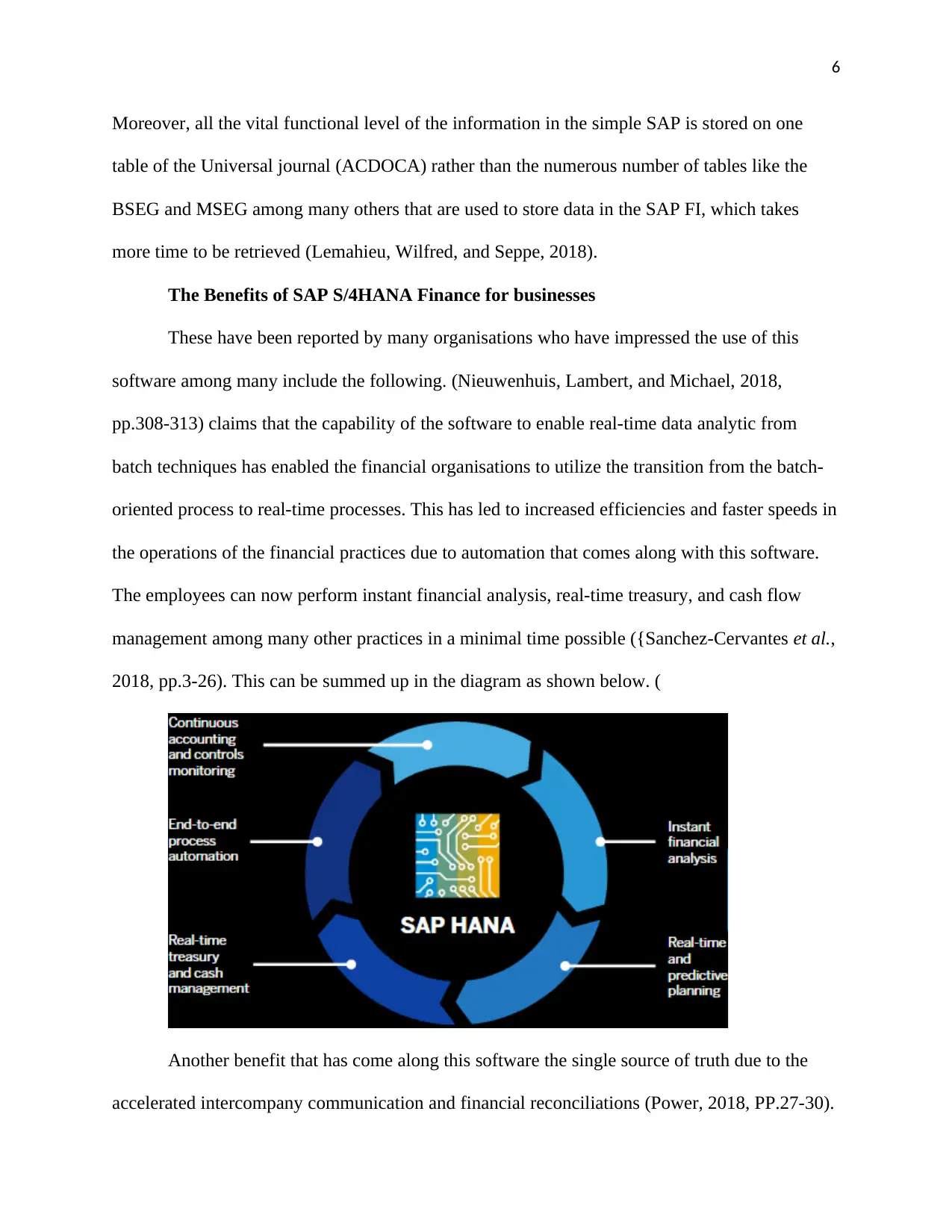
6
Moreover, all the vital functional level of the information in the simple SAP is stored on one
table of the Universal journal (ACDOCA) rather than the numerous number of tables like the
BSEG and MSEG among many others that are used to store data in the SAP FI, which takes
more time to be retrieved (Lemahieu, Wilfred, and Seppe, 2018).
The Benefits of SAP S/4HANA Finance for businesses
These have been reported by many organisations who have impressed the use of this
software among many include the following. (Nieuwenhuis, Lambert, and Michael, 2018,
pp.308-313) claims that the capability of the software to enable real-time data analytic from
batch techniques has enabled the financial organisations to utilize the transition from the batch-
oriented process to real-time processes. This has led to increased efficiencies and faster speeds in
the operations of the financial practices due to automation that comes along with this software.
The employees can now perform instant financial analysis, real-time treasury, and cash flow
management among many other practices in a minimal time possible ({Sanchez-Cervantes et al.,
2018, pp.3-26). This can be summed up in the diagram as shown below. (
Another benefit that has come along this software the single source of truth due to the
accelerated intercompany communication and financial reconciliations (Power, 2018, PP.27-30).
Moreover, all the vital functional level of the information in the simple SAP is stored on one
table of the Universal journal (ACDOCA) rather than the numerous number of tables like the
BSEG and MSEG among many others that are used to store data in the SAP FI, which takes
more time to be retrieved (Lemahieu, Wilfred, and Seppe, 2018).
The Benefits of SAP S/4HANA Finance for businesses
These have been reported by many organisations who have impressed the use of this
software among many include the following. (Nieuwenhuis, Lambert, and Michael, 2018,
pp.308-313) claims that the capability of the software to enable real-time data analytic from
batch techniques has enabled the financial organisations to utilize the transition from the batch-
oriented process to real-time processes. This has led to increased efficiencies and faster speeds in
the operations of the financial practices due to automation that comes along with this software.
The employees can now perform instant financial analysis, real-time treasury, and cash flow
management among many other practices in a minimal time possible ({Sanchez-Cervantes et al.,
2018, pp.3-26). This can be summed up in the diagram as shown below. (
Another benefit that has come along this software the single source of truth due to the
accelerated intercompany communication and financial reconciliations (Power, 2018, PP.27-30).
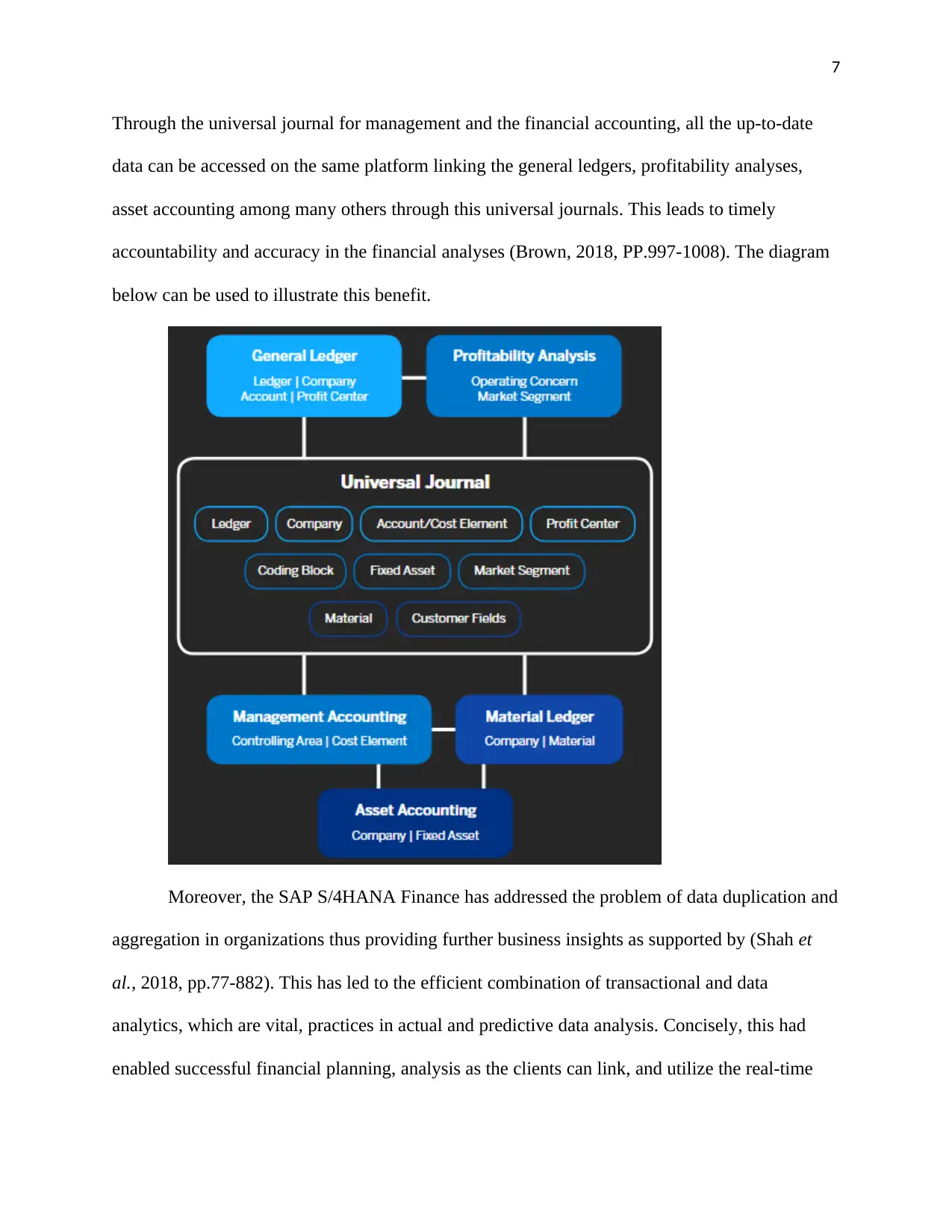
7
Through the universal journal for management and the financial accounting, all the up-to-date
data can be accessed on the same platform linking the general ledgers, profitability analyses,
asset accounting among many others through this universal journals. This leads to timely
accountability and accuracy in the financial analyses (Brown, 2018, PP.997-1008). The diagram
below can be used to illustrate this benefit.
Moreover, the SAP S/4HANA Finance has addressed the problem of data duplication and
aggregation in organizations thus providing further business insights as supported by (Shah et
al., 2018, pp.77-882). This has led to the efficient combination of transactional and data
analytics, which are vital, practices in actual and predictive data analysis. Concisely, this had
enabled successful financial planning, analysis as the clients can link, and utilize the real-time
Through the universal journal for management and the financial accounting, all the up-to-date
data can be accessed on the same platform linking the general ledgers, profitability analyses,
asset accounting among many others through this universal journals. This leads to timely
accountability and accuracy in the financial analyses (Brown, 2018, PP.997-1008). The diagram
below can be used to illustrate this benefit.
Moreover, the SAP S/4HANA Finance has addressed the problem of data duplication and
aggregation in organizations thus providing further business insights as supported by (Shah et
al., 2018, pp.77-882). This has led to the efficient combination of transactional and data
analytics, which are vital, practices in actual and predictive data analysis. Concisely, this had
enabled successful financial planning, analysis as the clients can link, and utilize the real-time
Paraphrase This Document
Need a fresh take? Get an instant paraphrase of this document with our AI Paraphraser
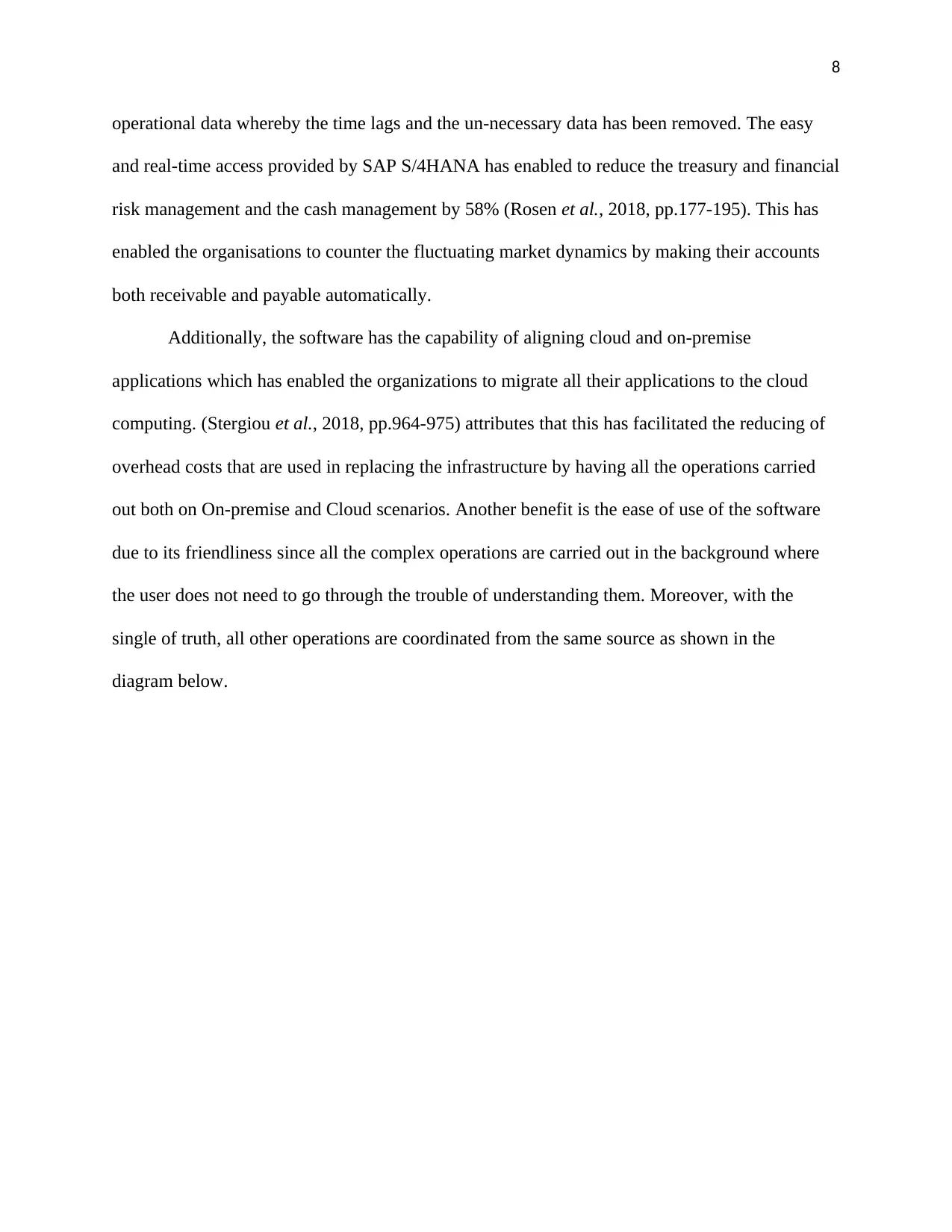
8
operational data whereby the time lags and the un-necessary data has been removed. The easy
and real-time access provided by SAP S/4HANA has enabled to reduce the treasury and financial
risk management and the cash management by 58% (Rosen et al., 2018, pp.177-195). This has
enabled the organisations to counter the fluctuating market dynamics by making their accounts
both receivable and payable automatically.
Additionally, the software has the capability of aligning cloud and on-premise
applications which has enabled the organizations to migrate all their applications to the cloud
computing. (Stergiou et al., 2018, pp.964-975) attributes that this has facilitated the reducing of
overhead costs that are used in replacing the infrastructure by having all the operations carried
out both on On-premise and Cloud scenarios. Another benefit is the ease of use of the software
due to its friendliness since all the complex operations are carried out in the background where
the user does not need to go through the trouble of understanding them. Moreover, with the
single of truth, all other operations are coordinated from the same source as shown in the
diagram below.
operational data whereby the time lags and the un-necessary data has been removed. The easy
and real-time access provided by SAP S/4HANA has enabled to reduce the treasury and financial
risk management and the cash management by 58% (Rosen et al., 2018, pp.177-195). This has
enabled the organisations to counter the fluctuating market dynamics by making their accounts
both receivable and payable automatically.
Additionally, the software has the capability of aligning cloud and on-premise
applications which has enabled the organizations to migrate all their applications to the cloud
computing. (Stergiou et al., 2018, pp.964-975) attributes that this has facilitated the reducing of
overhead costs that are used in replacing the infrastructure by having all the operations carried
out both on On-premise and Cloud scenarios. Another benefit is the ease of use of the software
due to its friendliness since all the complex operations are carried out in the background where
the user does not need to go through the trouble of understanding them. Moreover, with the
single of truth, all other operations are coordinated from the same source as shown in the
diagram below.
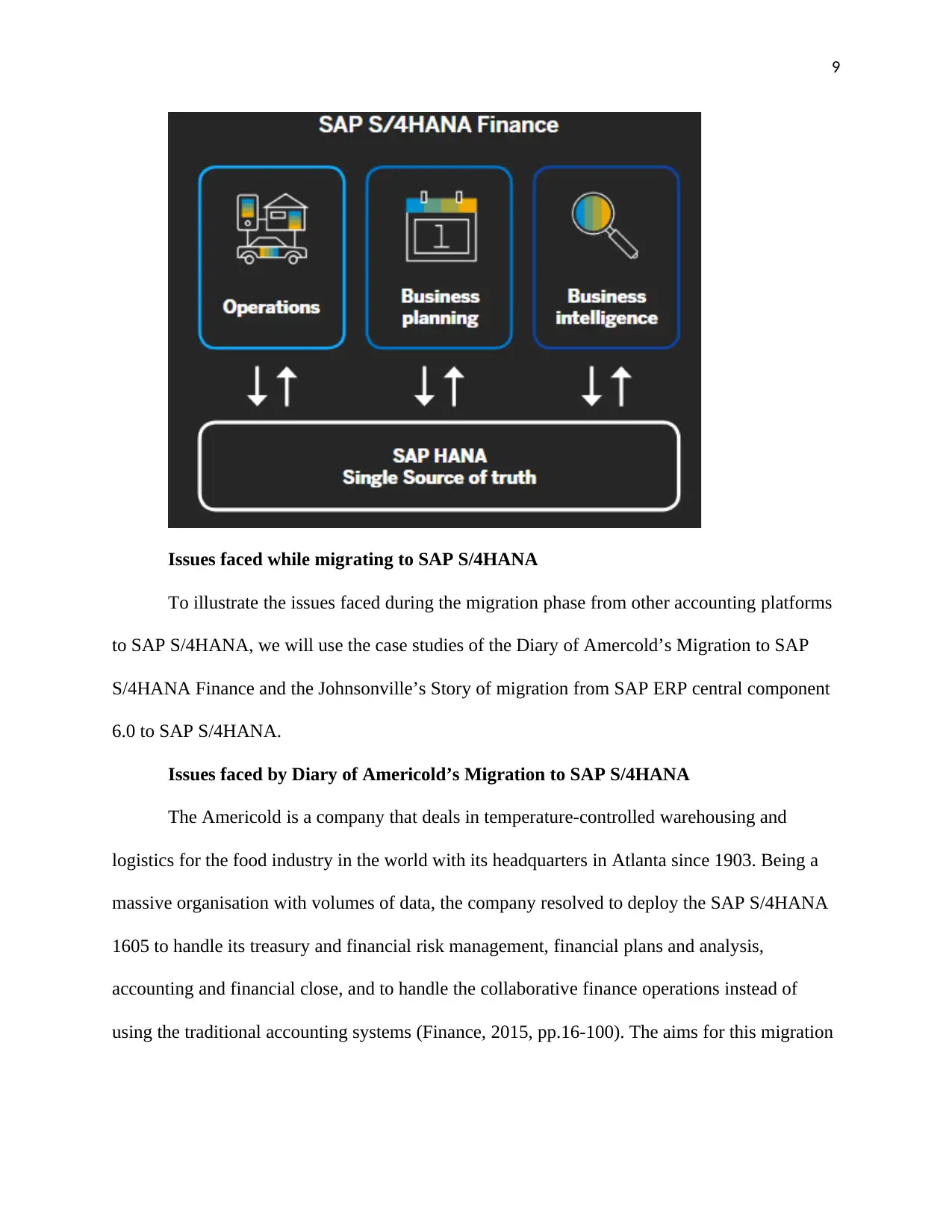
9
Issues faced while migrating to SAP S/4HANA
To illustrate the issues faced during the migration phase from other accounting platforms
to SAP S/4HANA, we will use the case studies of the Diary of Amercold’s Migration to SAP
S/4HANA Finance and the Johnsonville’s Story of migration from SAP ERP central component
6.0 to SAP S/4HANA.
Issues faced by Diary of Americold’s Migration to SAP S/4HANA
The Americold is a company that deals in temperature-controlled warehousing and
logistics for the food industry in the world with its headquarters in Atlanta since 1903. Being a
massive organisation with volumes of data, the company resolved to deploy the SAP S/4HANA
1605 to handle its treasury and financial risk management, financial plans and analysis,
accounting and financial close, and to handle the collaborative finance operations instead of
using the traditional accounting systems (Finance, 2015, pp.16-100). The aims for this migration
Issues faced while migrating to SAP S/4HANA
To illustrate the issues faced during the migration phase from other accounting platforms
to SAP S/4HANA, we will use the case studies of the Diary of Amercold’s Migration to SAP
S/4HANA Finance and the Johnsonville’s Story of migration from SAP ERP central component
6.0 to SAP S/4HANA.
Issues faced by Diary of Americold’s Migration to SAP S/4HANA
The Americold is a company that deals in temperature-controlled warehousing and
logistics for the food industry in the world with its headquarters in Atlanta since 1903. Being a
massive organisation with volumes of data, the company resolved to deploy the SAP S/4HANA
1605 to handle its treasury and financial risk management, financial plans and analysis,
accounting and financial close, and to handle the collaborative finance operations instead of
using the traditional accounting systems (Finance, 2015, pp.16-100). The aims for this migration
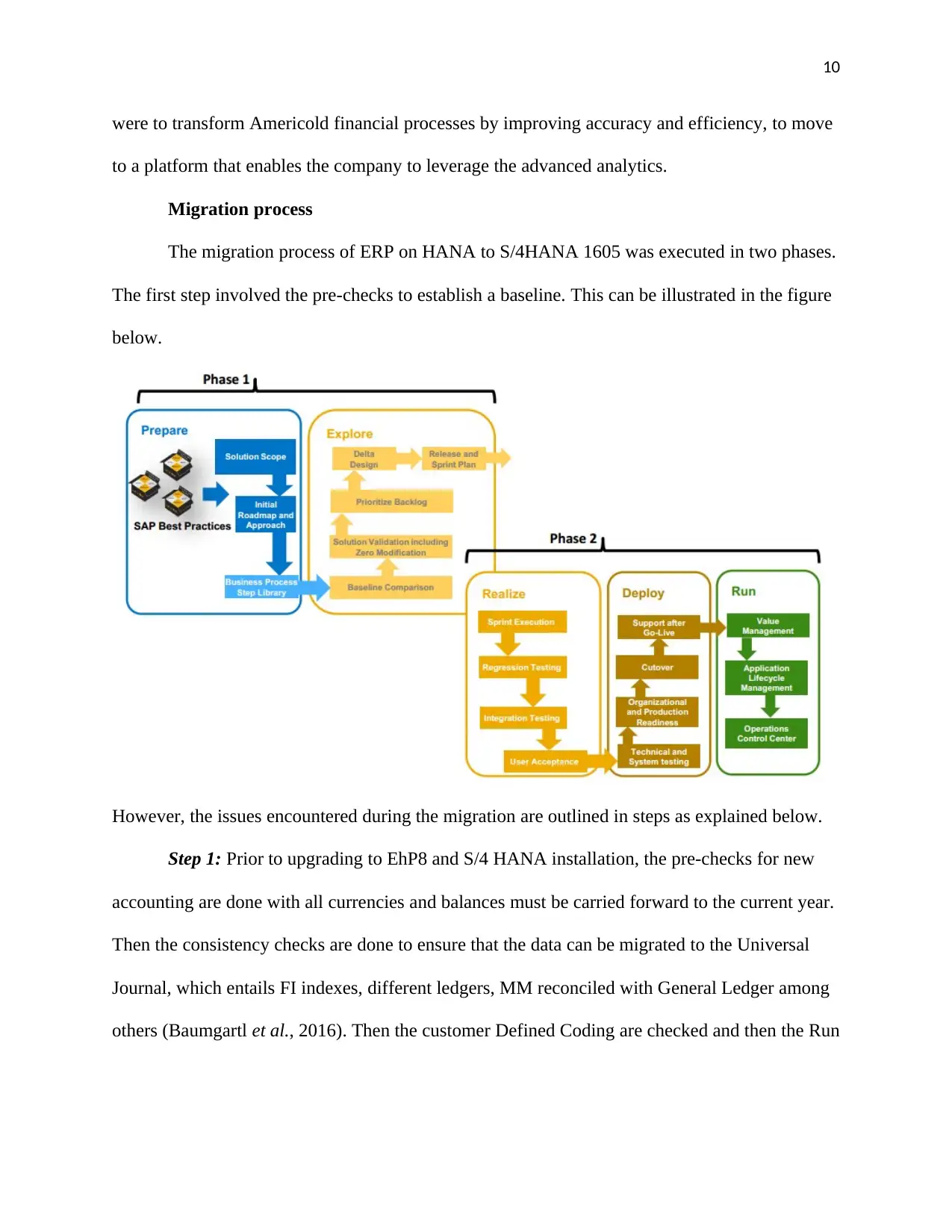
10
were to transform Americold financial processes by improving accuracy and efficiency, to move
to a platform that enables the company to leverage the advanced analytics.
Migration process
The migration process of ERP on HANA to S/4HANA 1605 was executed in two phases.
The first step involved the pre-checks to establish a baseline. This can be illustrated in the figure
below.
However, the issues encountered during the migration are outlined in steps as explained below.
Step 1: Prior to upgrading to EhP8 and S/4 HANA installation, the pre-checks for new
accounting are done with all currencies and balances must be carried forward to the current year.
Then the consistency checks are done to ensure that the data can be migrated to the Universal
Journal, which entails FI indexes, different ledgers, MM reconciled with General Ledger among
others (Baumgartl et al., 2016). Then the customer Defined Coding are checked and then the Run
were to transform Americold financial processes by improving accuracy and efficiency, to move
to a platform that enables the company to leverage the advanced analytics.
Migration process
The migration process of ERP on HANA to S/4HANA 1605 was executed in two phases.
The first step involved the pre-checks to establish a baseline. This can be illustrated in the figure
below.
However, the issues encountered during the migration are outlined in steps as explained below.
Step 1: Prior to upgrading to EhP8 and S/4 HANA installation, the pre-checks for new
accounting are done with all currencies and balances must be carried forward to the current year.
Then the consistency checks are done to ensure that the data can be migrated to the Universal
Journal, which entails FI indexes, different ledgers, MM reconciled with General Ledger among
others (Baumgartl et al., 2016). Then the customer Defined Coding are checked and then the Run
Secure Best Marks with AI Grader
Need help grading? Try our AI Grader for instant feedback on your assignments.
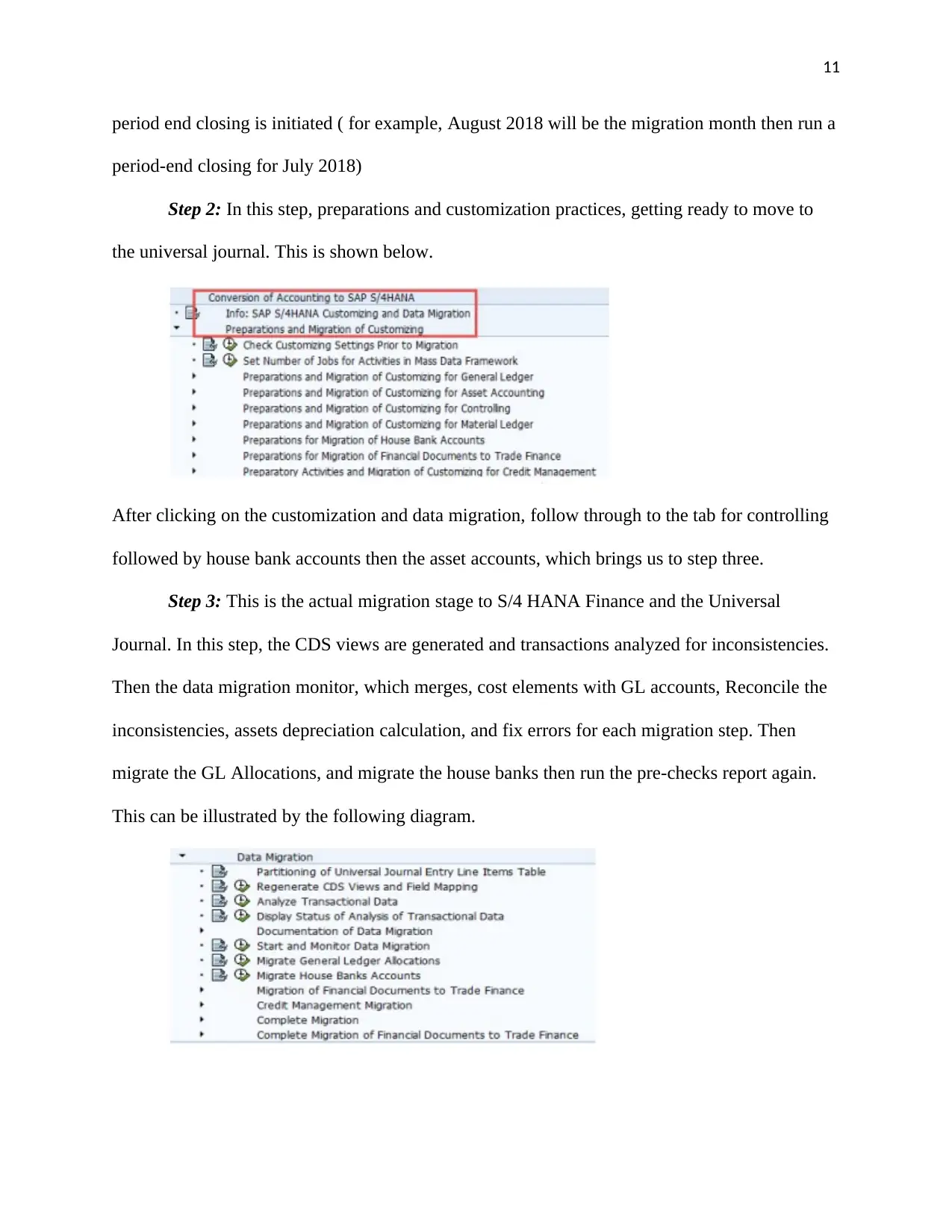
11
period end closing is initiated ( for example, August 2018 will be the migration month then run a
period-end closing for July 2018)
Step 2: In this step, preparations and customization practices, getting ready to move to
the universal journal. This is shown below.
After clicking on the customization and data migration, follow through to the tab for controlling
followed by house bank accounts then the asset accounts, which brings us to step three.
Step 3: This is the actual migration stage to S/4 HANA Finance and the Universal
Journal. In this step, the CDS views are generated and transactions analyzed for inconsistencies.
Then the data migration monitor, which merges, cost elements with GL accounts, Reconcile the
inconsistencies, assets depreciation calculation, and fix errors for each migration step. Then
migrate the GL Allocations, and migrate the house banks then run the pre-checks report again.
This can be illustrated by the following diagram.
period end closing is initiated ( for example, August 2018 will be the migration month then run a
period-end closing for July 2018)
Step 2: In this step, preparations and customization practices, getting ready to move to
the universal journal. This is shown below.
After clicking on the customization and data migration, follow through to the tab for controlling
followed by house bank accounts then the asset accounts, which brings us to step three.
Step 3: This is the actual migration stage to S/4 HANA Finance and the Universal
Journal. In this step, the CDS views are generated and transactions analyzed for inconsistencies.
Then the data migration monitor, which merges, cost elements with GL accounts, Reconcile the
inconsistencies, assets depreciation calculation, and fix errors for each migration step. Then
migrate the GL Allocations, and migrate the house banks then run the pre-checks report again.
This can be illustrated by the following diagram.
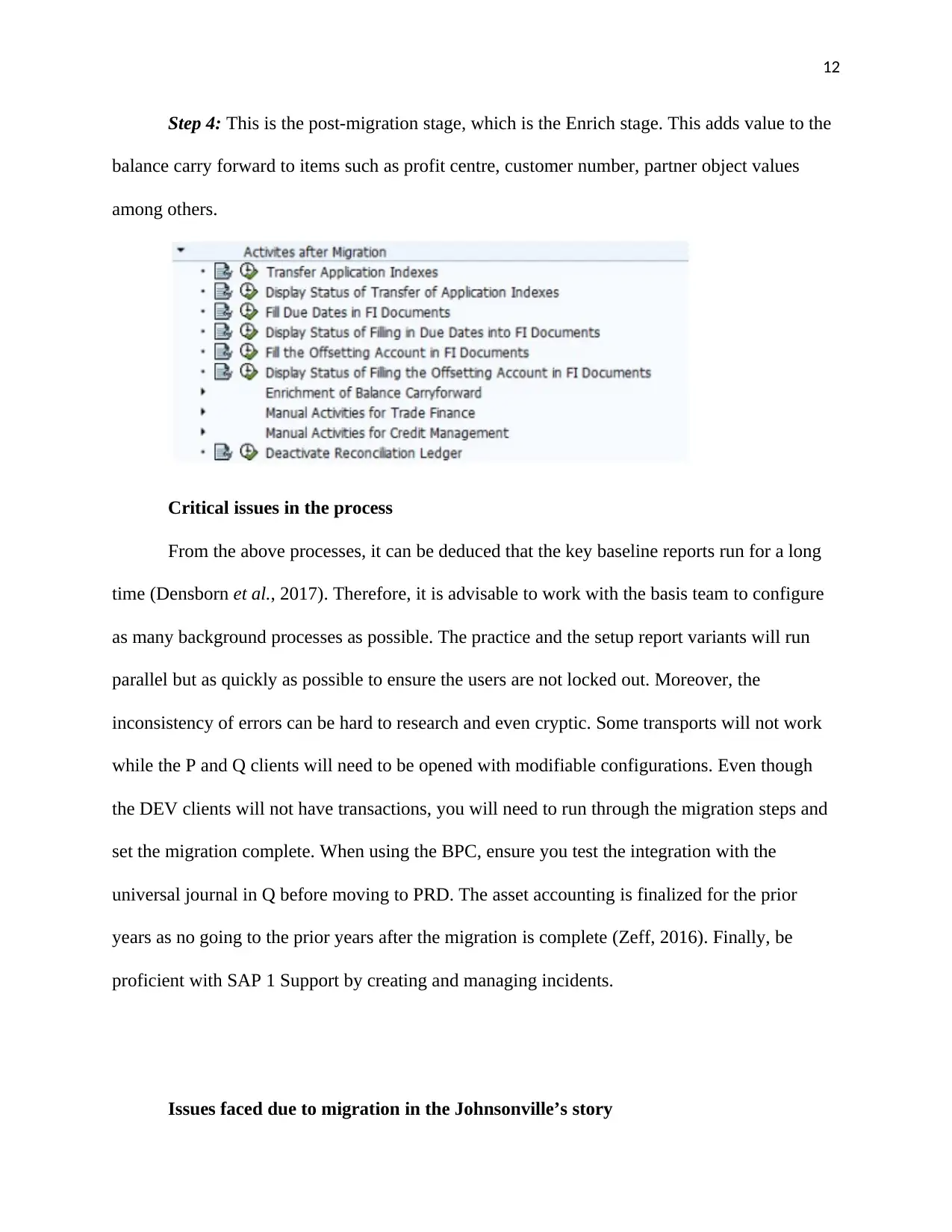
12
Step 4: This is the post-migration stage, which is the Enrich stage. This adds value to the
balance carry forward to items such as profit centre, customer number, partner object values
among others.
Critical issues in the process
From the above processes, it can be deduced that the key baseline reports run for a long
time (Densborn et al., 2017). Therefore, it is advisable to work with the basis team to configure
as many background processes as possible. The practice and the setup report variants will run
parallel but as quickly as possible to ensure the users are not locked out. Moreover, the
inconsistency of errors can be hard to research and even cryptic. Some transports will not work
while the P and Q clients will need to be opened with modifiable configurations. Even though
the DEV clients will not have transactions, you will need to run through the migration steps and
set the migration complete. When using the BPC, ensure you test the integration with the
universal journal in Q before moving to PRD. The asset accounting is finalized for the prior
years as no going to the prior years after the migration is complete (Zeff, 2016). Finally, be
proficient with SAP 1 Support by creating and managing incidents.
Issues faced due to migration in the Johnsonville’s story
Step 4: This is the post-migration stage, which is the Enrich stage. This adds value to the
balance carry forward to items such as profit centre, customer number, partner object values
among others.
Critical issues in the process
From the above processes, it can be deduced that the key baseline reports run for a long
time (Densborn et al., 2017). Therefore, it is advisable to work with the basis team to configure
as many background processes as possible. The practice and the setup report variants will run
parallel but as quickly as possible to ensure the users are not locked out. Moreover, the
inconsistency of errors can be hard to research and even cryptic. Some transports will not work
while the P and Q clients will need to be opened with modifiable configurations. Even though
the DEV clients will not have transactions, you will need to run through the migration steps and
set the migration complete. When using the BPC, ensure you test the integration with the
universal journal in Q before moving to PRD. The asset accounting is finalized for the prior
years as no going to the prior years after the migration is complete (Zeff, 2016). Finally, be
proficient with SAP 1 Support by creating and managing incidents.
Issues faced due to migration in the Johnsonville’s story
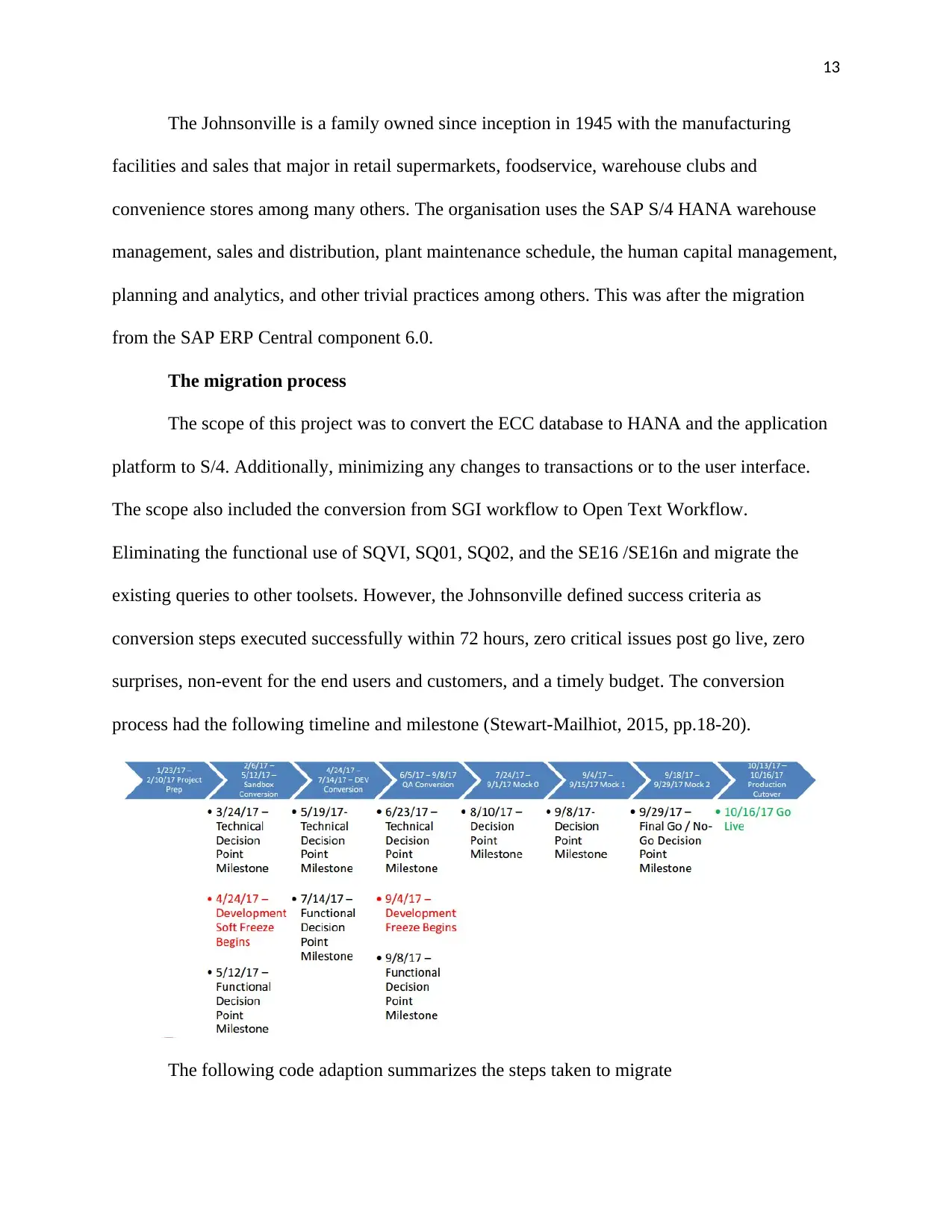
13
The Johnsonville is a family owned since inception in 1945 with the manufacturing
facilities and sales that major in retail supermarkets, foodservice, warehouse clubs and
convenience stores among many others. The organisation uses the SAP S/4 HANA warehouse
management, sales and distribution, plant maintenance schedule, the human capital management,
planning and analytics, and other trivial practices among others. This was after the migration
from the SAP ERP Central component 6.0.
The migration process
The scope of this project was to convert the ECC database to HANA and the application
platform to S/4. Additionally, minimizing any changes to transactions or to the user interface.
The scope also included the conversion from SGI workflow to Open Text Workflow.
Eliminating the functional use of SQVI, SQ01, SQ02, and the SE16 /SE16n and migrate the
existing queries to other toolsets. However, the Johnsonville defined success criteria as
conversion steps executed successfully within 72 hours, zero critical issues post go live, zero
surprises, non-event for the end users and customers, and a timely budget. The conversion
process had the following timeline and milestone (Stewart-Mailhiot, 2015, pp.18-20).
The following code adaption summarizes the steps taken to migrate
The Johnsonville is a family owned since inception in 1945 with the manufacturing
facilities and sales that major in retail supermarkets, foodservice, warehouse clubs and
convenience stores among many others. The organisation uses the SAP S/4 HANA warehouse
management, sales and distribution, plant maintenance schedule, the human capital management,
planning and analytics, and other trivial practices among others. This was after the migration
from the SAP ERP Central component 6.0.
The migration process
The scope of this project was to convert the ECC database to HANA and the application
platform to S/4. Additionally, minimizing any changes to transactions or to the user interface.
The scope also included the conversion from SGI workflow to Open Text Workflow.
Eliminating the functional use of SQVI, SQ01, SQ02, and the SE16 /SE16n and migrate the
existing queries to other toolsets. However, the Johnsonville defined success criteria as
conversion steps executed successfully within 72 hours, zero critical issues post go live, zero
surprises, non-event for the end users and customers, and a timely budget. The conversion
process had the following timeline and milestone (Stewart-Mailhiot, 2015, pp.18-20).
The following code adaption summarizes the steps taken to migrate
Paraphrase This Document
Need a fresh take? Get an instant paraphrase of this document with our AI Paraphraser
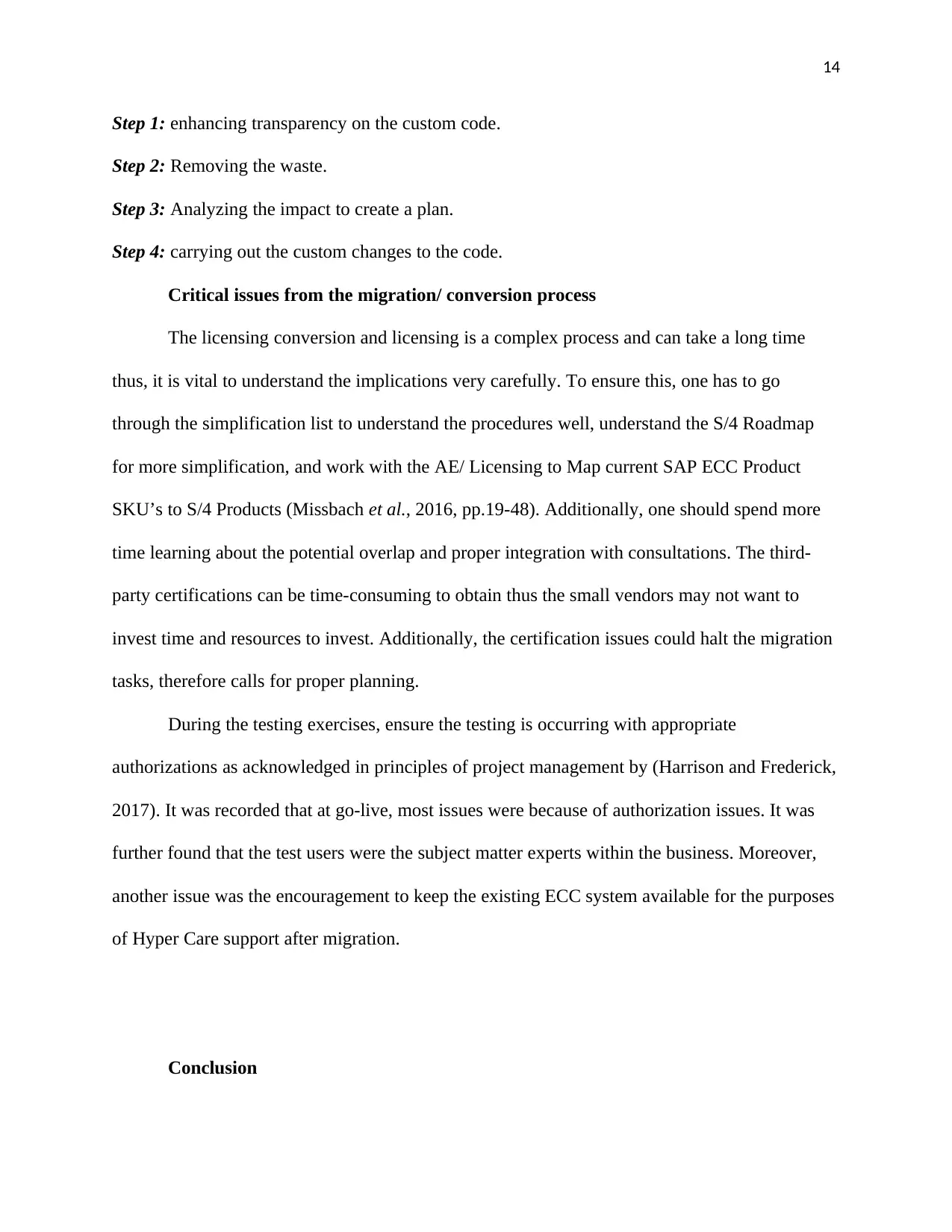
14
Step 1: enhancing transparency on the custom code.
Step 2: Removing the waste.
Step 3: Analyzing the impact to create a plan.
Step 4: carrying out the custom changes to the code.
Critical issues from the migration/ conversion process
The licensing conversion and licensing is a complex process and can take a long time
thus, it is vital to understand the implications very carefully. To ensure this, one has to go
through the simplification list to understand the procedures well, understand the S/4 Roadmap
for more simplification, and work with the AE/ Licensing to Map current SAP ECC Product
SKU’s to S/4 Products (Missbach et al., 2016, pp.19-48). Additionally, one should spend more
time learning about the potential overlap and proper integration with consultations. The third-
party certifications can be time-consuming to obtain thus the small vendors may not want to
invest time and resources to invest. Additionally, the certification issues could halt the migration
tasks, therefore calls for proper planning.
During the testing exercises, ensure the testing is occurring with appropriate
authorizations as acknowledged in principles of project management by (Harrison and Frederick,
2017). It was recorded that at go-live, most issues were because of authorization issues. It was
further found that the test users were the subject matter experts within the business. Moreover,
another issue was the encouragement to keep the existing ECC system available for the purposes
of Hyper Care support after migration.
Conclusion
Step 1: enhancing transparency on the custom code.
Step 2: Removing the waste.
Step 3: Analyzing the impact to create a plan.
Step 4: carrying out the custom changes to the code.
Critical issues from the migration/ conversion process
The licensing conversion and licensing is a complex process and can take a long time
thus, it is vital to understand the implications very carefully. To ensure this, one has to go
through the simplification list to understand the procedures well, understand the S/4 Roadmap
for more simplification, and work with the AE/ Licensing to Map current SAP ECC Product
SKU’s to S/4 Products (Missbach et al., 2016, pp.19-48). Additionally, one should spend more
time learning about the potential overlap and proper integration with consultations. The third-
party certifications can be time-consuming to obtain thus the small vendors may not want to
invest time and resources to invest. Additionally, the certification issues could halt the migration
tasks, therefore calls for proper planning.
During the testing exercises, ensure the testing is occurring with appropriate
authorizations as acknowledged in principles of project management by (Harrison and Frederick,
2017). It was recorded that at go-live, most issues were because of authorization issues. It was
further found that the test users were the subject matter experts within the business. Moreover,
another issue was the encouragement to keep the existing ECC system available for the purposes
of Hyper Care support after migration.
Conclusion
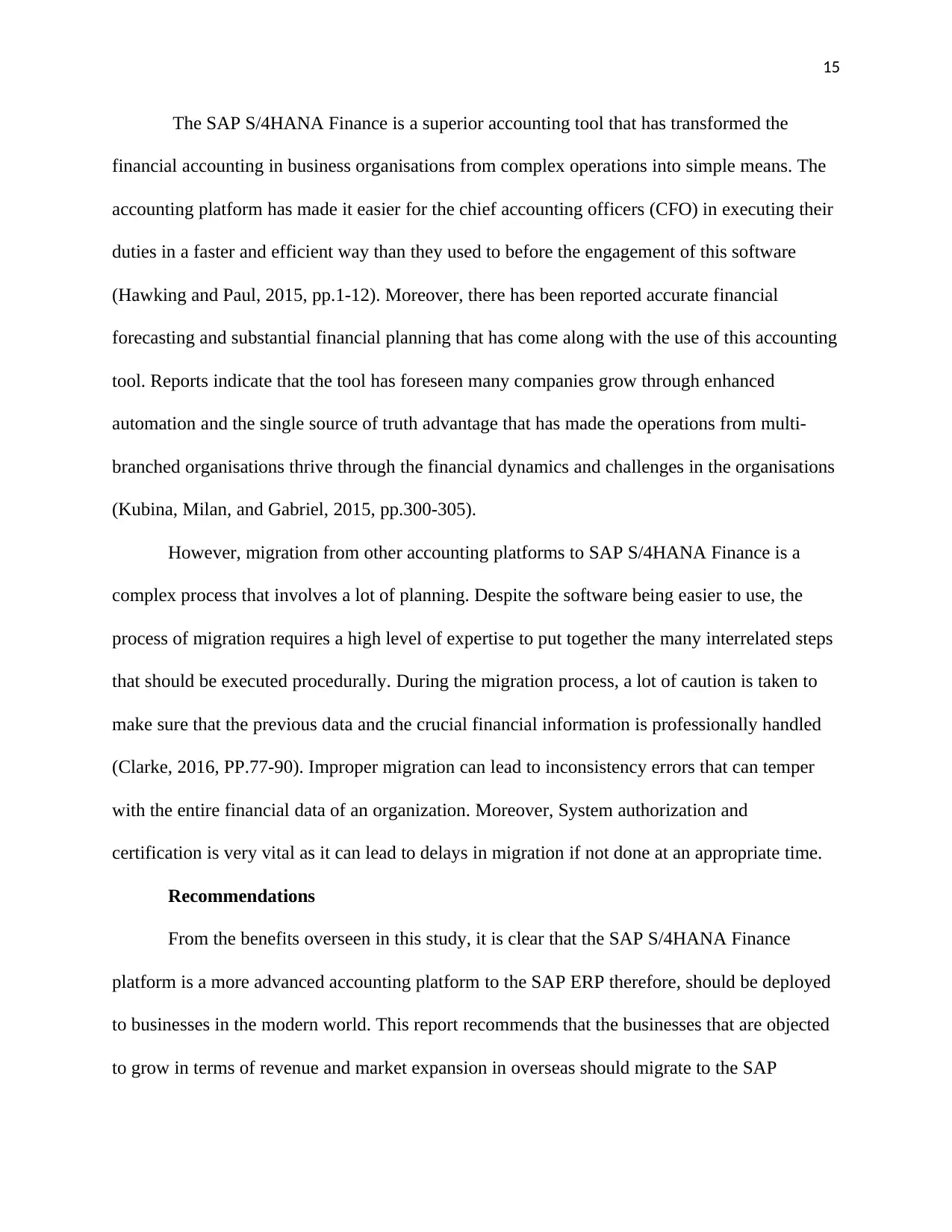
15
The SAP S/4HANA Finance is a superior accounting tool that has transformed the
financial accounting in business organisations from complex operations into simple means. The
accounting platform has made it easier for the chief accounting officers (CFO) in executing their
duties in a faster and efficient way than they used to before the engagement of this software
(Hawking and Paul, 2015, pp.1-12). Moreover, there has been reported accurate financial
forecasting and substantial financial planning that has come along with the use of this accounting
tool. Reports indicate that the tool has foreseen many companies grow through enhanced
automation and the single source of truth advantage that has made the operations from multi-
branched organisations thrive through the financial dynamics and challenges in the organisations
(Kubina, Milan, and Gabriel, 2015, pp.300-305).
However, migration from other accounting platforms to SAP S/4HANA Finance is a
complex process that involves a lot of planning. Despite the software being easier to use, the
process of migration requires a high level of expertise to put together the many interrelated steps
that should be executed procedurally. During the migration process, a lot of caution is taken to
make sure that the previous data and the crucial financial information is professionally handled
(Clarke, 2016, PP.77-90). Improper migration can lead to inconsistency errors that can temper
with the entire financial data of an organization. Moreover, System authorization and
certification is very vital as it can lead to delays in migration if not done at an appropriate time.
Recommendations
From the benefits overseen in this study, it is clear that the SAP S/4HANA Finance
platform is a more advanced accounting platform to the SAP ERP therefore, should be deployed
to businesses in the modern world. This report recommends that the businesses that are objected
to grow in terms of revenue and market expansion in overseas should migrate to the SAP
The SAP S/4HANA Finance is a superior accounting tool that has transformed the
financial accounting in business organisations from complex operations into simple means. The
accounting platform has made it easier for the chief accounting officers (CFO) in executing their
duties in a faster and efficient way than they used to before the engagement of this software
(Hawking and Paul, 2015, pp.1-12). Moreover, there has been reported accurate financial
forecasting and substantial financial planning that has come along with the use of this accounting
tool. Reports indicate that the tool has foreseen many companies grow through enhanced
automation and the single source of truth advantage that has made the operations from multi-
branched organisations thrive through the financial dynamics and challenges in the organisations
(Kubina, Milan, and Gabriel, 2015, pp.300-305).
However, migration from other accounting platforms to SAP S/4HANA Finance is a
complex process that involves a lot of planning. Despite the software being easier to use, the
process of migration requires a high level of expertise to put together the many interrelated steps
that should be executed procedurally. During the migration process, a lot of caution is taken to
make sure that the previous data and the crucial financial information is professionally handled
(Clarke, 2016, PP.77-90). Improper migration can lead to inconsistency errors that can temper
with the entire financial data of an organization. Moreover, System authorization and
certification is very vital as it can lead to delays in migration if not done at an appropriate time.
Recommendations
From the benefits overseen in this study, it is clear that the SAP S/4HANA Finance
platform is a more advanced accounting platform to the SAP ERP therefore, should be deployed
to businesses in the modern world. This report recommends that the businesses that are objected
to grow in terms of revenue and market expansion in overseas should migrate to the SAP
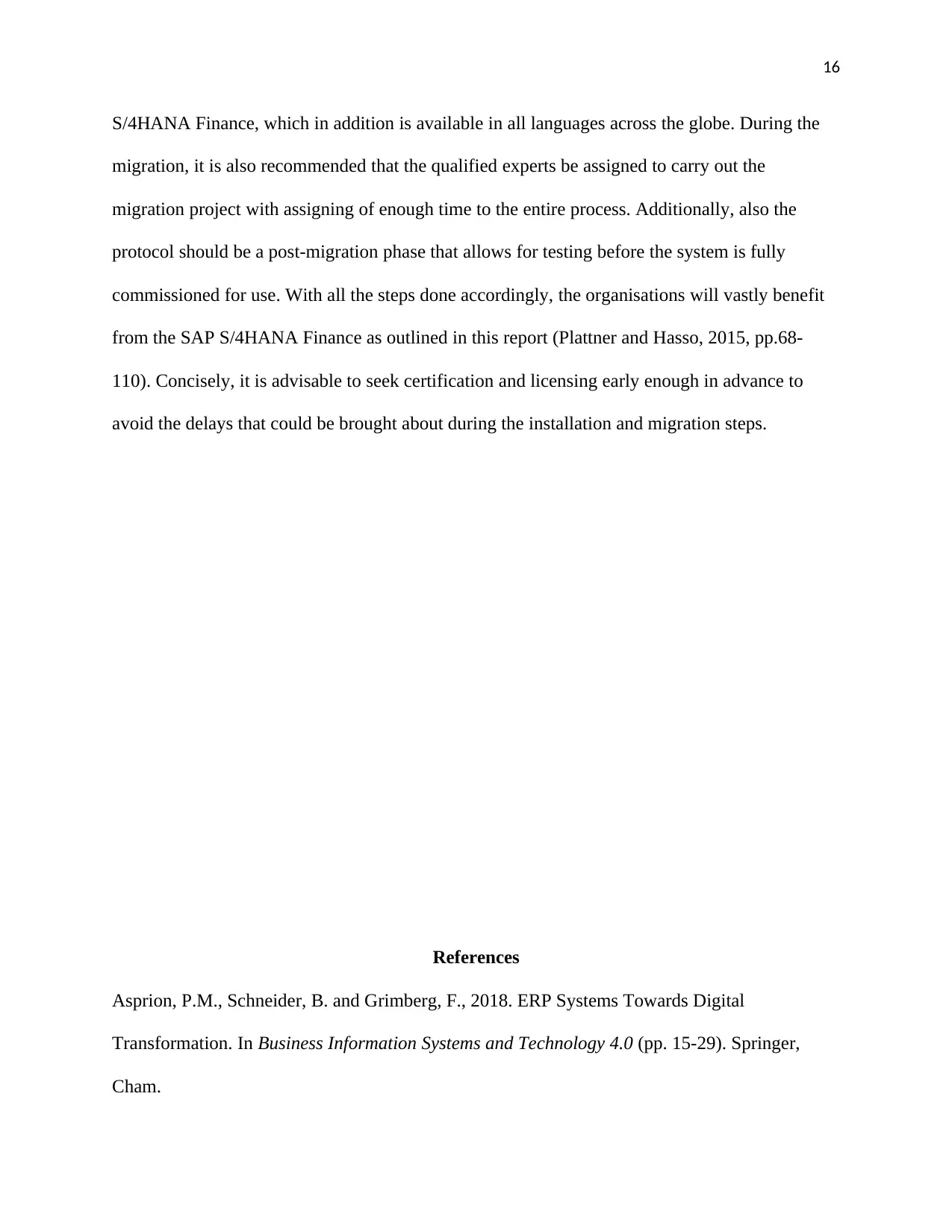
16
S/4HANA Finance, which in addition is available in all languages across the globe. During the
migration, it is also recommended that the qualified experts be assigned to carry out the
migration project with assigning of enough time to the entire process. Additionally, also the
protocol should be a post-migration phase that allows for testing before the system is fully
commissioned for use. With all the steps done accordingly, the organisations will vastly benefit
from the SAP S/4HANA Finance as outlined in this report (Plattner and Hasso, 2015, pp.68-
110). Concisely, it is advisable to seek certification and licensing early enough in advance to
avoid the delays that could be brought about during the installation and migration steps.
References
Asprion, P.M., Schneider, B. and Grimberg, F., 2018. ERP Systems Towards Digital
Transformation. In Business Information Systems and Technology 4.0 (pp. 15-29). Springer,
Cham.
S/4HANA Finance, which in addition is available in all languages across the globe. During the
migration, it is also recommended that the qualified experts be assigned to carry out the
migration project with assigning of enough time to the entire process. Additionally, also the
protocol should be a post-migration phase that allows for testing before the system is fully
commissioned for use. With all the steps done accordingly, the organisations will vastly benefit
from the SAP S/4HANA Finance as outlined in this report (Plattner and Hasso, 2015, pp.68-
110). Concisely, it is advisable to seek certification and licensing early enough in advance to
avoid the delays that could be brought about during the installation and migration steps.
References
Asprion, P.M., Schneider, B. and Grimberg, F., 2018. ERP Systems Towards Digital
Transformation. In Business Information Systems and Technology 4.0 (pp. 15-29). Springer,
Cham.
Secure Best Marks with AI Grader
Need help grading? Try our AI Grader for instant feedback on your assignments.
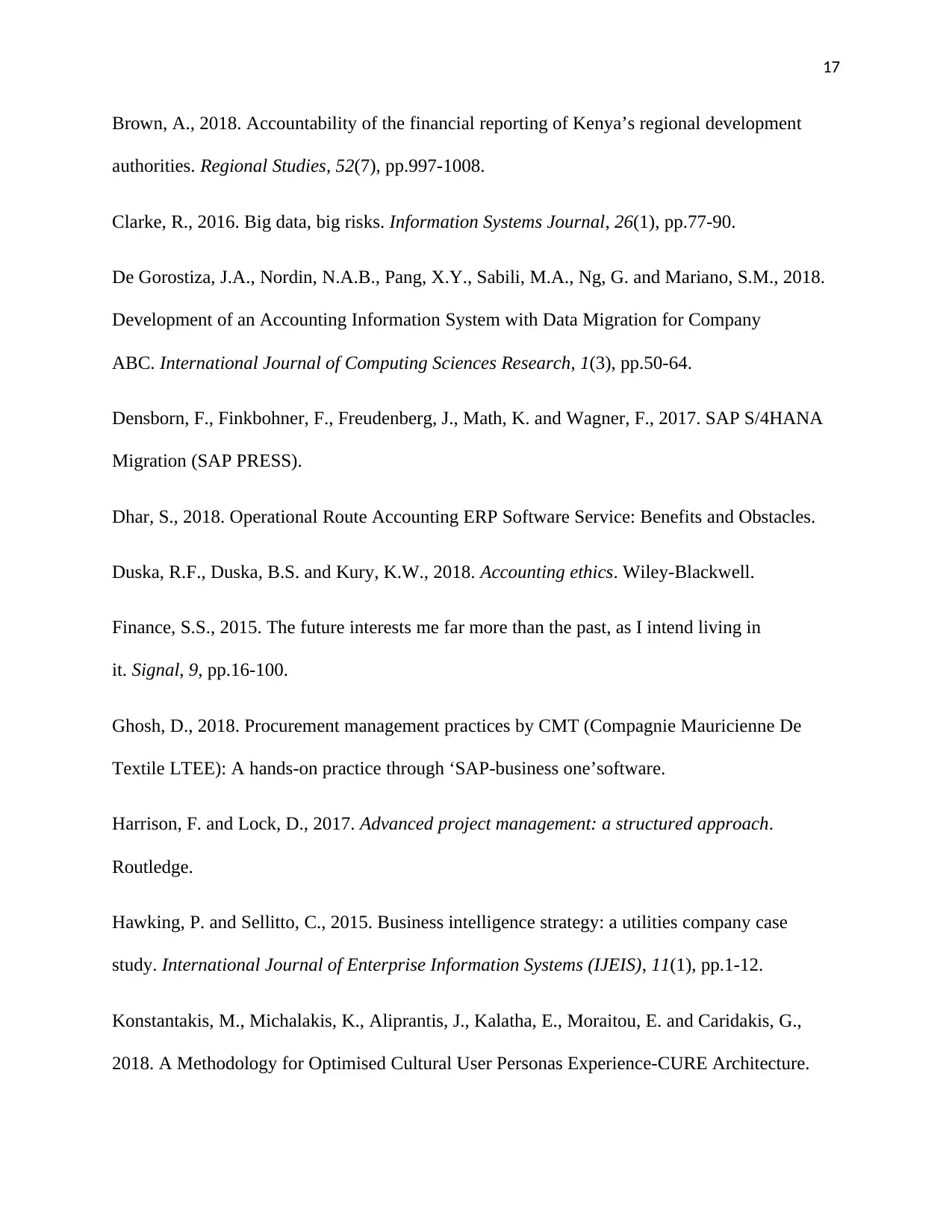
17
Brown, A., 2018. Accountability of the financial reporting of Kenya’s regional development
authorities. Regional Studies, 52(7), pp.997-1008.
Clarke, R., 2016. Big data, big risks. Information Systems Journal, 26(1), pp.77-90.
De Gorostiza, J.A., Nordin, N.A.B., Pang, X.Y., Sabili, M.A., Ng, G. and Mariano, S.M., 2018.
Development of an Accounting Information System with Data Migration for Company
ABC. International Journal of Computing Sciences Research, 1(3), pp.50-64.
Densborn, F., Finkbohner, F., Freudenberg, J., Math, K. and Wagner, F., 2017. SAP S/4HANA
Migration (SAP PRESS).
Dhar, S., 2018. Operational Route Accounting ERP Software Service: Benefits and Obstacles.
Duska, R.F., Duska, B.S. and Kury, K.W., 2018. Accounting ethics. Wiley-Blackwell.
Finance, S.S., 2015. The future interests me far more than the past, as I intend living in
it. Signal, 9, pp.16-100.
Ghosh, D., 2018. Procurement management practices by CMT (Compagnie Mauricienne De
Textile LTEE): A hands-on practice through ‘SAP-business one’software.
Harrison, F. and Lock, D., 2017. Advanced project management: a structured approach.
Routledge.
Hawking, P. and Sellitto, C., 2015. Business intelligence strategy: a utilities company case
study. International Journal of Enterprise Information Systems (IJEIS), 11(1), pp.1-12.
Konstantakis, M., Michalakis, K., Aliprantis, J., Kalatha, E., Moraitou, E. and Caridakis, G.,
2018. A Methodology for Optimised Cultural User Personas Experience-CURE Architecture.
Brown, A., 2018. Accountability of the financial reporting of Kenya’s regional development
authorities. Regional Studies, 52(7), pp.997-1008.
Clarke, R., 2016. Big data, big risks. Information Systems Journal, 26(1), pp.77-90.
De Gorostiza, J.A., Nordin, N.A.B., Pang, X.Y., Sabili, M.A., Ng, G. and Mariano, S.M., 2018.
Development of an Accounting Information System with Data Migration for Company
ABC. International Journal of Computing Sciences Research, 1(3), pp.50-64.
Densborn, F., Finkbohner, F., Freudenberg, J., Math, K. and Wagner, F., 2017. SAP S/4HANA
Migration (SAP PRESS).
Dhar, S., 2018. Operational Route Accounting ERP Software Service: Benefits and Obstacles.
Duska, R.F., Duska, B.S. and Kury, K.W., 2018. Accounting ethics. Wiley-Blackwell.
Finance, S.S., 2015. The future interests me far more than the past, as I intend living in
it. Signal, 9, pp.16-100.
Ghosh, D., 2018. Procurement management practices by CMT (Compagnie Mauricienne De
Textile LTEE): A hands-on practice through ‘SAP-business one’software.
Harrison, F. and Lock, D., 2017. Advanced project management: a structured approach.
Routledge.
Hawking, P. and Sellitto, C., 2015. Business intelligence strategy: a utilities company case
study. International Journal of Enterprise Information Systems (IJEIS), 11(1), pp.1-12.
Konstantakis, M., Michalakis, K., Aliprantis, J., Kalatha, E., Moraitou, E. and Caridakis, G.,
2018. A Methodology for Optimised Cultural User Personas Experience-CURE Architecture.
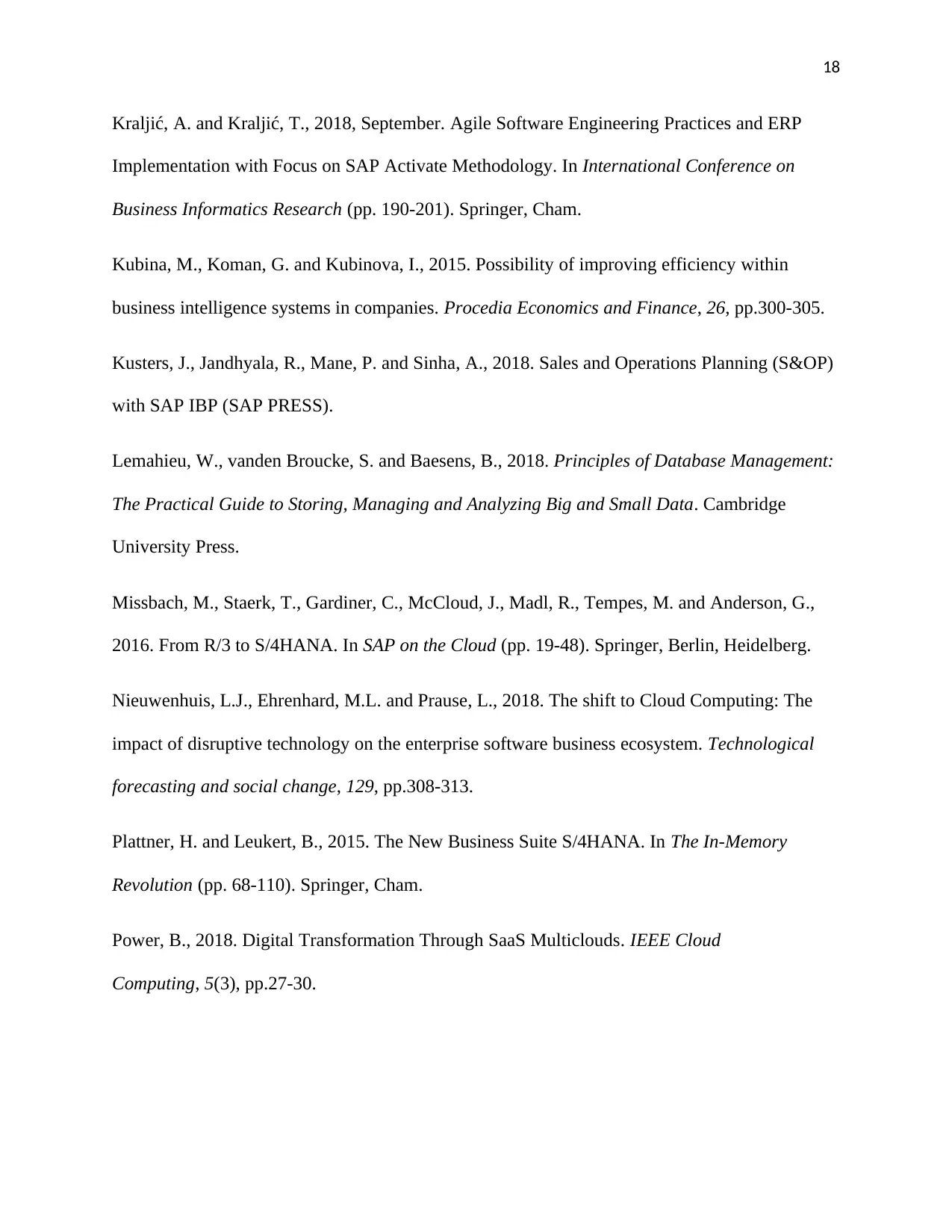
18
Kraljić, A. and Kraljić, T., 2018, September. Agile Software Engineering Practices and ERP
Implementation with Focus on SAP Activate Methodology. In International Conference on
Business Informatics Research (pp. 190-201). Springer, Cham.
Kubina, M., Koman, G. and Kubinova, I., 2015. Possibility of improving efficiency within
business intelligence systems in companies. Procedia Economics and Finance, 26, pp.300-305.
Kusters, J., Jandhyala, R., Mane, P. and Sinha, A., 2018. Sales and Operations Planning (S&OP)
with SAP IBP (SAP PRESS).
Lemahieu, W., vanden Broucke, S. and Baesens, B., 2018. Principles of Database Management:
The Practical Guide to Storing, Managing and Analyzing Big and Small Data. Cambridge
University Press.
Missbach, M., Staerk, T., Gardiner, C., McCloud, J., Madl, R., Tempes, M. and Anderson, G.,
2016. From R/3 to S/4HANA. In SAP on the Cloud (pp. 19-48). Springer, Berlin, Heidelberg.
Nieuwenhuis, L.J., Ehrenhard, M.L. and Prause, L., 2018. The shift to Cloud Computing: The
impact of disruptive technology on the enterprise software business ecosystem. Technological
forecasting and social change, 129, pp.308-313.
Plattner, H. and Leukert, B., 2015. The New Business Suite S/4HANA. In The In-Memory
Revolution (pp. 68-110). Springer, Cham.
Power, B., 2018. Digital Transformation Through SaaS Multiclouds. IEEE Cloud
Computing, 5(3), pp.27-30.
Kraljić, A. and Kraljić, T., 2018, September. Agile Software Engineering Practices and ERP
Implementation with Focus on SAP Activate Methodology. In International Conference on
Business Informatics Research (pp. 190-201). Springer, Cham.
Kubina, M., Koman, G. and Kubinova, I., 2015. Possibility of improving efficiency within
business intelligence systems in companies. Procedia Economics and Finance, 26, pp.300-305.
Kusters, J., Jandhyala, R., Mane, P. and Sinha, A., 2018. Sales and Operations Planning (S&OP)
with SAP IBP (SAP PRESS).
Lemahieu, W., vanden Broucke, S. and Baesens, B., 2018. Principles of Database Management:
The Practical Guide to Storing, Managing and Analyzing Big and Small Data. Cambridge
University Press.
Missbach, M., Staerk, T., Gardiner, C., McCloud, J., Madl, R., Tempes, M. and Anderson, G.,
2016. From R/3 to S/4HANA. In SAP on the Cloud (pp. 19-48). Springer, Berlin, Heidelberg.
Nieuwenhuis, L.J., Ehrenhard, M.L. and Prause, L., 2018. The shift to Cloud Computing: The
impact of disruptive technology on the enterprise software business ecosystem. Technological
forecasting and social change, 129, pp.308-313.
Plattner, H. and Leukert, B., 2015. The New Business Suite S/4HANA. In The In-Memory
Revolution (pp. 68-110). Springer, Cham.
Power, B., 2018. Digital Transformation Through SaaS Multiclouds. IEEE Cloud
Computing, 5(3), pp.27-30.
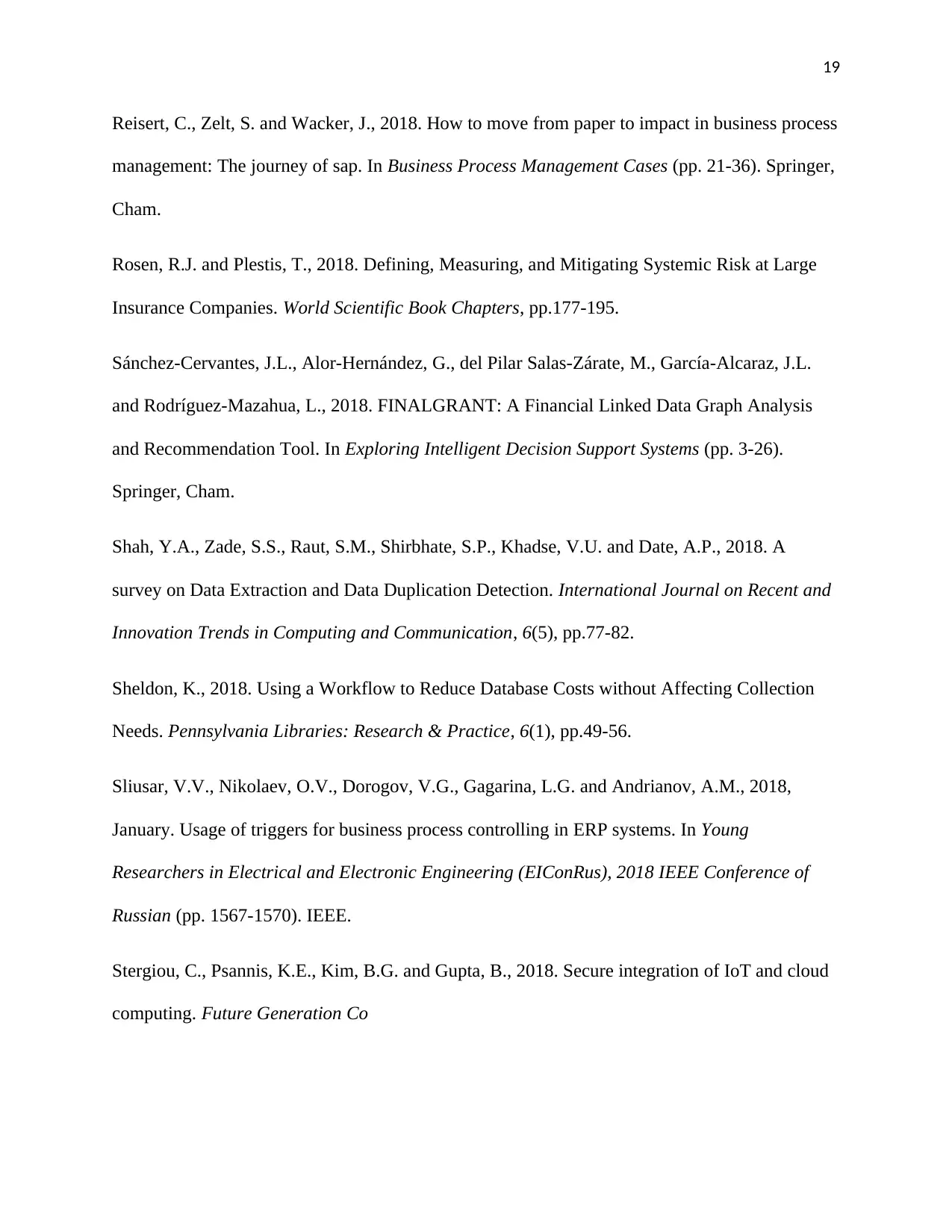
19
Reisert, C., Zelt, S. and Wacker, J., 2018. How to move from paper to impact in business process
management: The journey of sap. In Business Process Management Cases (pp. 21-36). Springer,
Cham.
Rosen, R.J. and Plestis, T., 2018. Defining, Measuring, and Mitigating Systemic Risk at Large
Insurance Companies. World Scientific Book Chapters, pp.177-195.
Sánchez-Cervantes, J.L., Alor-Hernández, G., del Pilar Salas-Zárate, M., García-Alcaraz, J.L.
and Rodríguez-Mazahua, L., 2018. FINALGRANT: A Financial Linked Data Graph Analysis
and Recommendation Tool. In Exploring Intelligent Decision Support Systems (pp. 3-26).
Springer, Cham.
Shah, Y.A., Zade, S.S., Raut, S.M., Shirbhate, S.P., Khadse, V.U. and Date, A.P., 2018. A
survey on Data Extraction and Data Duplication Detection. International Journal on Recent and
Innovation Trends in Computing and Communication, 6(5), pp.77-82.
Sheldon, K., 2018. Using a Workflow to Reduce Database Costs without Affecting Collection
Needs. Pennsylvania Libraries: Research & Practice, 6(1), pp.49-56.
Sliusar, V.V., Nikolaev, O.V., Dorogov, V.G., Gagarina, L.G. and Andrianov, A.M., 2018,
January. Usage of triggers for business process controlling in ERP systems. In Young
Researchers in Electrical and Electronic Engineering (EIConRus), 2018 IEEE Conference of
Russian (pp. 1567-1570). IEEE.
Stergiou, C., Psannis, K.E., Kim, B.G. and Gupta, B., 2018. Secure integration of IoT and cloud
computing. Future Generation Co
Reisert, C., Zelt, S. and Wacker, J., 2018. How to move from paper to impact in business process
management: The journey of sap. In Business Process Management Cases (pp. 21-36). Springer,
Cham.
Rosen, R.J. and Plestis, T., 2018. Defining, Measuring, and Mitigating Systemic Risk at Large
Insurance Companies. World Scientific Book Chapters, pp.177-195.
Sánchez-Cervantes, J.L., Alor-Hernández, G., del Pilar Salas-Zárate, M., García-Alcaraz, J.L.
and Rodríguez-Mazahua, L., 2018. FINALGRANT: A Financial Linked Data Graph Analysis
and Recommendation Tool. In Exploring Intelligent Decision Support Systems (pp. 3-26).
Springer, Cham.
Shah, Y.A., Zade, S.S., Raut, S.M., Shirbhate, S.P., Khadse, V.U. and Date, A.P., 2018. A
survey on Data Extraction and Data Duplication Detection. International Journal on Recent and
Innovation Trends in Computing and Communication, 6(5), pp.77-82.
Sheldon, K., 2018. Using a Workflow to Reduce Database Costs without Affecting Collection
Needs. Pennsylvania Libraries: Research & Practice, 6(1), pp.49-56.
Sliusar, V.V., Nikolaev, O.V., Dorogov, V.G., Gagarina, L.G. and Andrianov, A.M., 2018,
January. Usage of triggers for business process controlling in ERP systems. In Young
Researchers in Electrical and Electronic Engineering (EIConRus), 2018 IEEE Conference of
Russian (pp. 1567-1570). IEEE.
Stergiou, C., Psannis, K.E., Kim, B.G. and Gupta, B., 2018. Secure integration of IoT and cloud
computing. Future Generation Co
Paraphrase This Document
Need a fresh take? Get an instant paraphrase of this document with our AI Paraphraser
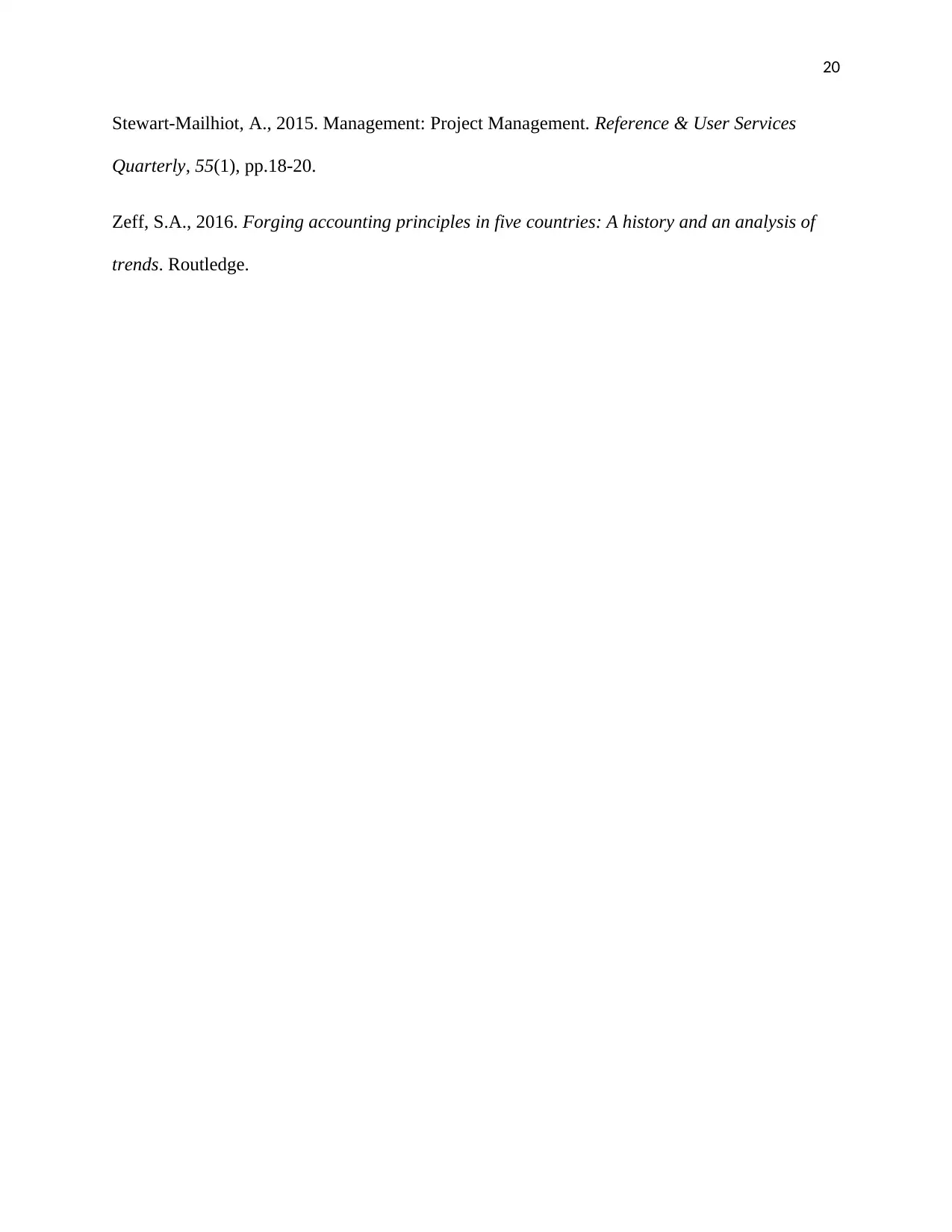
20
Stewart-Mailhiot, A., 2015. Management: Project Management. Reference & User Services
Quarterly, 55(1), pp.18-20.
Zeff, S.A., 2016. Forging accounting principles in five countries: A history and an analysis of
trends. Routledge.
Stewart-Mailhiot, A., 2015. Management: Project Management. Reference & User Services
Quarterly, 55(1), pp.18-20.
Zeff, S.A., 2016. Forging accounting principles in five countries: A history and an analysis of
trends. Routledge.
1 out of 20
Related Documents
Your All-in-One AI-Powered Toolkit for Academic Success.
+13062052269
info@desklib.com
Available 24*7 on WhatsApp / Email
![[object Object]](/_next/static/media/star-bottom.7253800d.svg)
Unlock your academic potential
© 2024 | Zucol Services PVT LTD | All rights reserved.




